Effective Business Communication: Self-Reflection and Diagnosis
VerifiedAdded on 2023/06/12
|18
|4841
|393
AI Summary
This essay analyzes the author's communication skills using five diagnostic tools and identifies areas for improvement. The article also includes a literature review on effective communication in business.
Contribute Materials
Your contribution can guide someone’s learning journey. Share your
documents today.
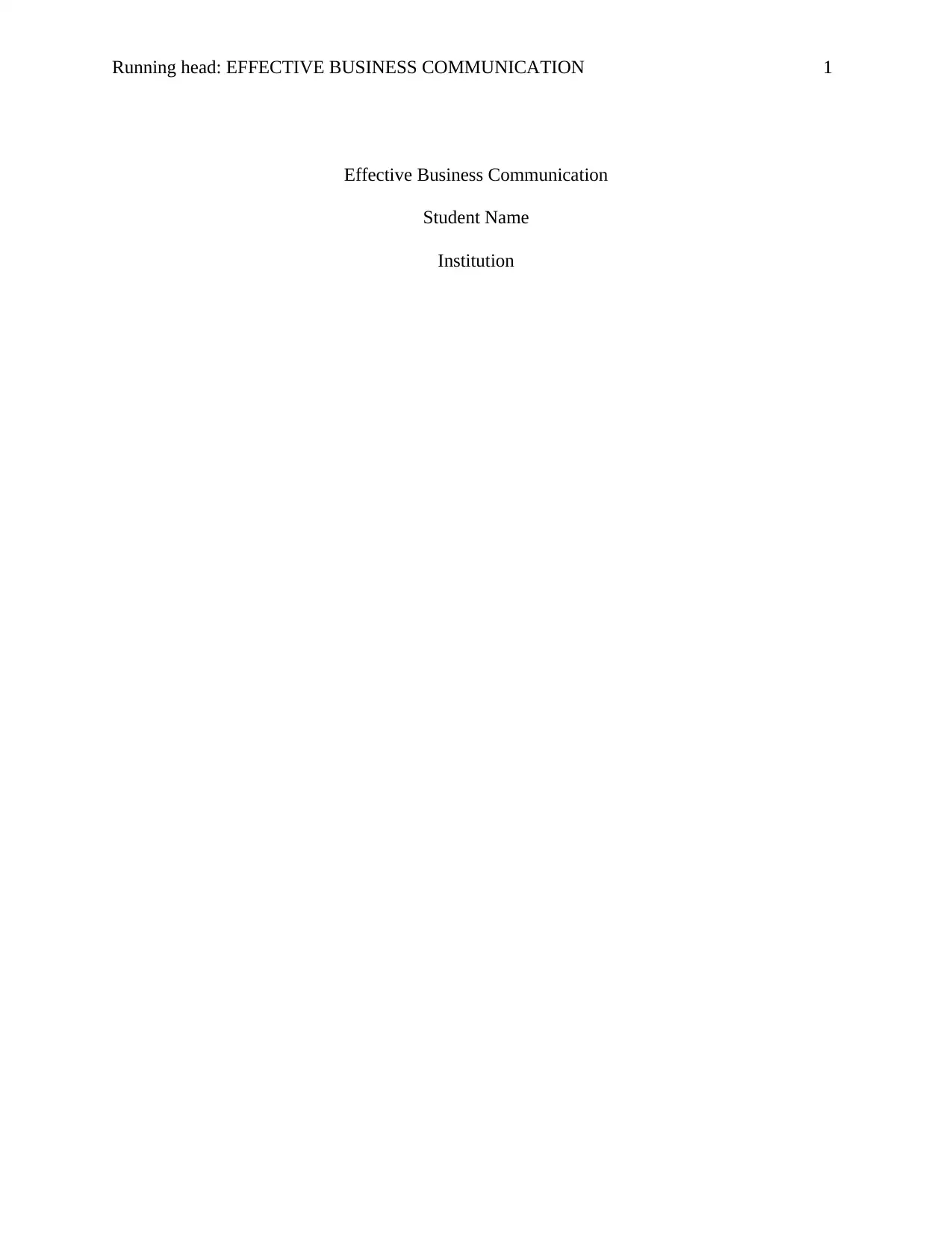
Running head: EFFECTIVE BUSINESS COMMUNICATION 1
Effective Business Communication
Student Name
Institution
Effective Business Communication
Student Name
Institution
Secure Best Marks with AI Grader
Need help grading? Try our AI Grader for instant feedback on your assignments.
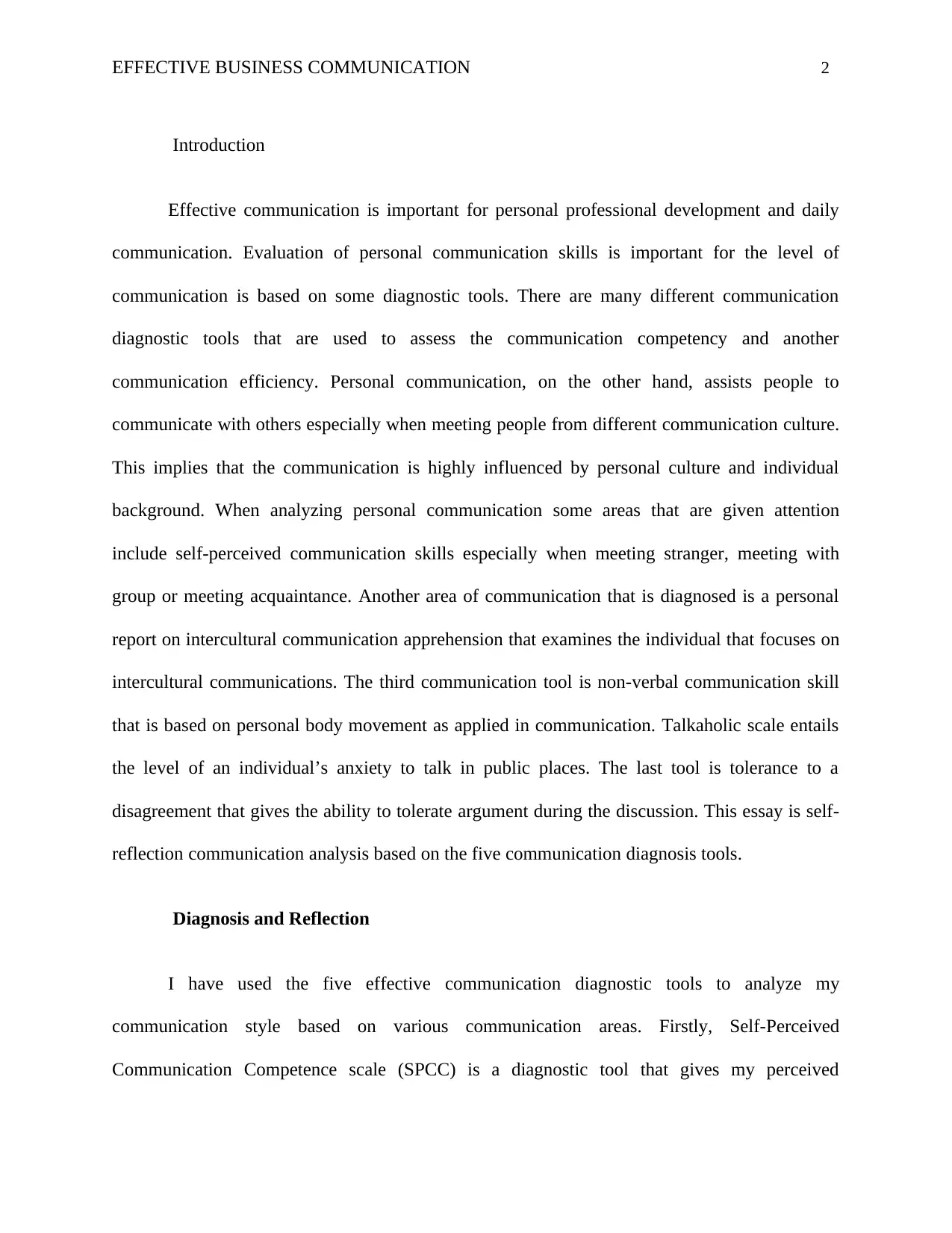
EFFECTIVE BUSINESS COMMUNICATION 2
Introduction
Effective communication is important for personal professional development and daily
communication. Evaluation of personal communication skills is important for the level of
communication is based on some diagnostic tools. There are many different communication
diagnostic tools that are used to assess the communication competency and another
communication efficiency. Personal communication, on the other hand, assists people to
communicate with others especially when meeting people from different communication culture.
This implies that the communication is highly influenced by personal culture and individual
background. When analyzing personal communication some areas that are given attention
include self-perceived communication skills especially when meeting stranger, meeting with
group or meeting acquaintance. Another area of communication that is diagnosed is a personal
report on intercultural communication apprehension that examines the individual that focuses on
intercultural communications. The third communication tool is non-verbal communication skill
that is based on personal body movement as applied in communication. Talkaholic scale entails
the level of an individual’s anxiety to talk in public places. The last tool is tolerance to a
disagreement that gives the ability to tolerate argument during the discussion. This essay is self-
reflection communication analysis based on the five communication diagnosis tools.
Diagnosis and Reflection
I have used the five effective communication diagnostic tools to analyze my
communication style based on various communication areas. Firstly, Self-Perceived
Communication Competence scale (SPCC) is a diagnostic tool that gives my perceived
Introduction
Effective communication is important for personal professional development and daily
communication. Evaluation of personal communication skills is important for the level of
communication is based on some diagnostic tools. There are many different communication
diagnostic tools that are used to assess the communication competency and another
communication efficiency. Personal communication, on the other hand, assists people to
communicate with others especially when meeting people from different communication culture.
This implies that the communication is highly influenced by personal culture and individual
background. When analyzing personal communication some areas that are given attention
include self-perceived communication skills especially when meeting stranger, meeting with
group or meeting acquaintance. Another area of communication that is diagnosed is a personal
report on intercultural communication apprehension that examines the individual that focuses on
intercultural communications. The third communication tool is non-verbal communication skill
that is based on personal body movement as applied in communication. Talkaholic scale entails
the level of an individual’s anxiety to talk in public places. The last tool is tolerance to a
disagreement that gives the ability to tolerate argument during the discussion. This essay is self-
reflection communication analysis based on the five communication diagnosis tools.
Diagnosis and Reflection
I have used the five effective communication diagnostic tools to analyze my
communication style based on various communication areas. Firstly, Self-Perceived
Communication Competence scale (SPCC) is a diagnostic tool that gives my perceived
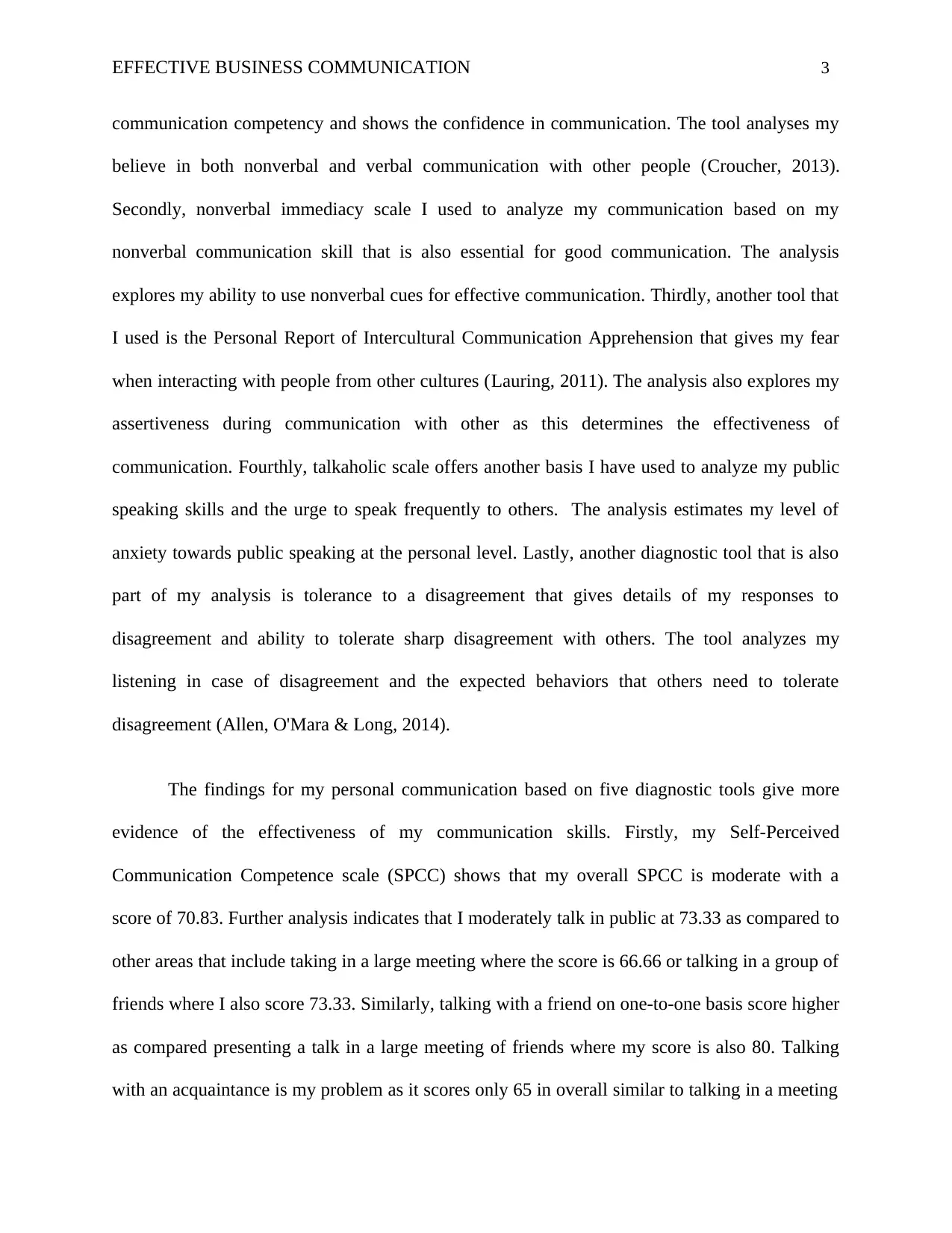
EFFECTIVE BUSINESS COMMUNICATION 3
communication competency and shows the confidence in communication. The tool analyses my
believe in both nonverbal and verbal communication with other people (Croucher, 2013).
Secondly, nonverbal immediacy scale I used to analyze my communication based on my
nonverbal communication skill that is also essential for good communication. The analysis
explores my ability to use nonverbal cues for effective communication. Thirdly, another tool that
I used is the Personal Report of Intercultural Communication Apprehension that gives my fear
when interacting with people from other cultures (Lauring, 2011). The analysis also explores my
assertiveness during communication with other as this determines the effectiveness of
communication. Fourthly, talkaholic scale offers another basis I have used to analyze my public
speaking skills and the urge to speak frequently to others. The analysis estimates my level of
anxiety towards public speaking at the personal level. Lastly, another diagnostic tool that is also
part of my analysis is tolerance to a disagreement that gives details of my responses to
disagreement and ability to tolerate sharp disagreement with others. The tool analyzes my
listening in case of disagreement and the expected behaviors that others need to tolerate
disagreement (Allen, O'Mara & Long, 2014).
The findings for my personal communication based on five diagnostic tools give more
evidence of the effectiveness of my communication skills. Firstly, my Self-Perceived
Communication Competence scale (SPCC) shows that my overall SPCC is moderate with a
score of 70.83. Further analysis indicates that I moderately talk in public at 73.33 as compared to
other areas that include taking in a large meeting where the score is 66.66 or talking in a group of
friends where I also score 73.33. Similarly, talking with a friend on one-to-one basis score higher
as compared presenting a talk in a large meeting of friends where my score is also 80. Talking
with an acquaintance is my problem as it scores only 65 in overall similar to talking in a meeting
communication competency and shows the confidence in communication. The tool analyses my
believe in both nonverbal and verbal communication with other people (Croucher, 2013).
Secondly, nonverbal immediacy scale I used to analyze my communication based on my
nonverbal communication skill that is also essential for good communication. The analysis
explores my ability to use nonverbal cues for effective communication. Thirdly, another tool that
I used is the Personal Report of Intercultural Communication Apprehension that gives my fear
when interacting with people from other cultures (Lauring, 2011). The analysis also explores my
assertiveness during communication with other as this determines the effectiveness of
communication. Fourthly, talkaholic scale offers another basis I have used to analyze my public
speaking skills and the urge to speak frequently to others. The analysis estimates my level of
anxiety towards public speaking at the personal level. Lastly, another diagnostic tool that is also
part of my analysis is tolerance to a disagreement that gives details of my responses to
disagreement and ability to tolerate sharp disagreement with others. The tool analyzes my
listening in case of disagreement and the expected behaviors that others need to tolerate
disagreement (Allen, O'Mara & Long, 2014).
The findings for my personal communication based on five diagnostic tools give more
evidence of the effectiveness of my communication skills. Firstly, my Self-Perceived
Communication Competence scale (SPCC) shows that my overall SPCC is moderate with a
score of 70.83. Further analysis indicates that I moderately talk in public at 73.33 as compared to
other areas that include taking in a large meeting where the score is 66.66 or talking in a group of
friends where I also score 73.33. Similarly, talking with a friend on one-to-one basis score higher
as compared presenting a talk in a large meeting of friends where my score is also 80. Talking
with an acquaintance is my problem as it scores only 65 in overall similar to talking in a meeting
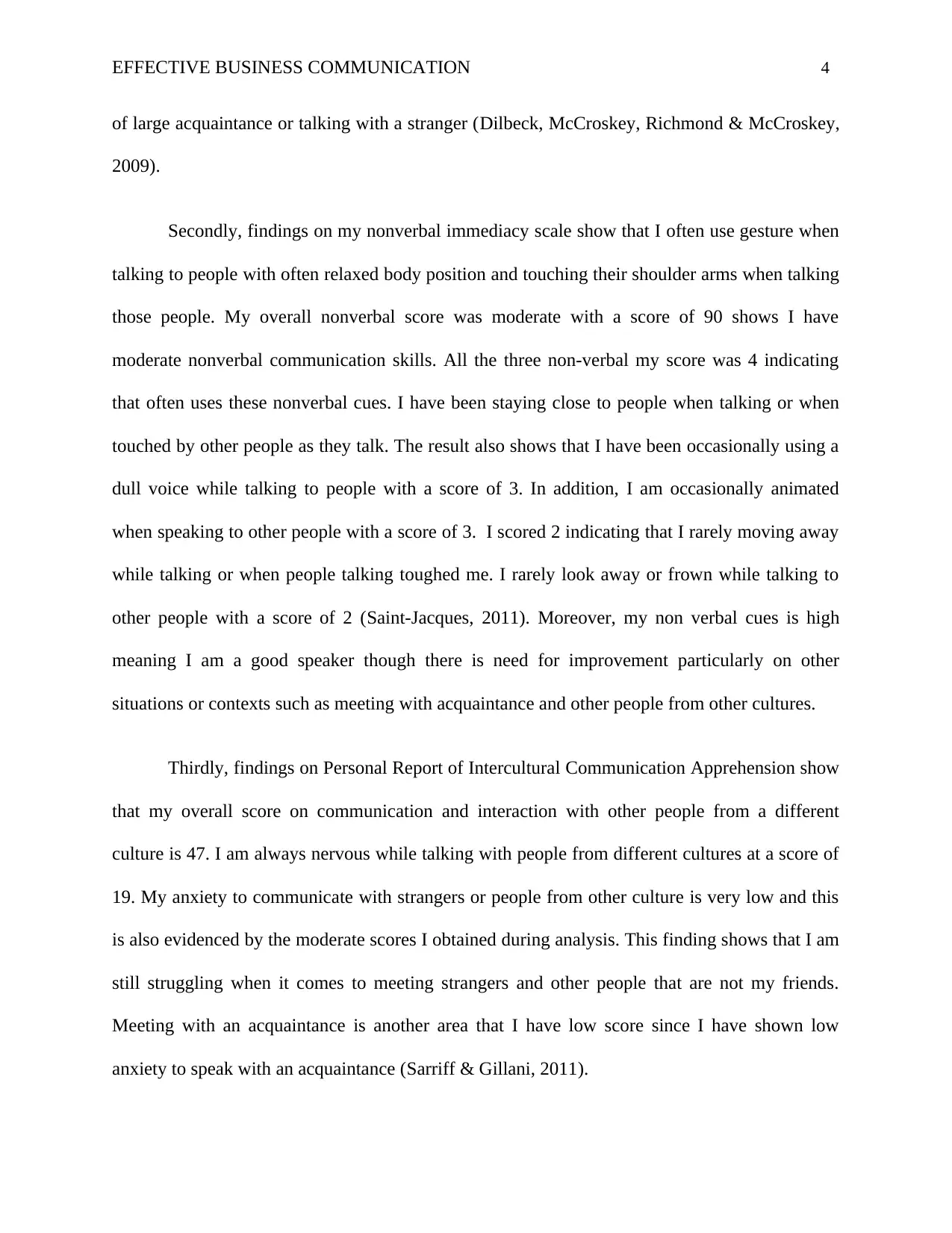
EFFECTIVE BUSINESS COMMUNICATION 4
of large acquaintance or talking with a stranger (Dilbeck, McCroskey, Richmond & McCroskey,
2009).
Secondly, findings on my nonverbal immediacy scale show that I often use gesture when
talking to people with often relaxed body position and touching their shoulder arms when talking
those people. My overall nonverbal score was moderate with a score of 90 shows I have
moderate nonverbal communication skills. All the three non-verbal my score was 4 indicating
that often uses these nonverbal cues. I have been staying close to people when talking or when
touched by other people as they talk. The result also shows that I have been occasionally using a
dull voice while talking to people with a score of 3. In addition, I am occasionally animated
when speaking to other people with a score of 3. I scored 2 indicating that I rarely moving away
while talking or when people talking toughed me. I rarely look away or frown while talking to
other people with a score of 2 (Saint-Jacques, 2011). Moreover, my non verbal cues is high
meaning I am a good speaker though there is need for improvement particularly on other
situations or contexts such as meeting with acquaintance and other people from other cultures.
Thirdly, findings on Personal Report of Intercultural Communication Apprehension show
that my overall score on communication and interaction with other people from a different
culture is 47. I am always nervous while talking with people from different cultures at a score of
19. My anxiety to communicate with strangers or people from other culture is very low and this
is also evidenced by the moderate scores I obtained during analysis. This finding shows that I am
still struggling when it comes to meeting strangers and other people that are not my friends.
Meeting with an acquaintance is another area that I have low score since I have shown low
anxiety to speak with an acquaintance (Sarriff & Gillani, 2011).
of large acquaintance or talking with a stranger (Dilbeck, McCroskey, Richmond & McCroskey,
2009).
Secondly, findings on my nonverbal immediacy scale show that I often use gesture when
talking to people with often relaxed body position and touching their shoulder arms when talking
those people. My overall nonverbal score was moderate with a score of 90 shows I have
moderate nonverbal communication skills. All the three non-verbal my score was 4 indicating
that often uses these nonverbal cues. I have been staying close to people when talking or when
touched by other people as they talk. The result also shows that I have been occasionally using a
dull voice while talking to people with a score of 3. In addition, I am occasionally animated
when speaking to other people with a score of 3. I scored 2 indicating that I rarely moving away
while talking or when people talking toughed me. I rarely look away or frown while talking to
other people with a score of 2 (Saint-Jacques, 2011). Moreover, my non verbal cues is high
meaning I am a good speaker though there is need for improvement particularly on other
situations or contexts such as meeting with acquaintance and other people from other cultures.
Thirdly, findings on Personal Report of Intercultural Communication Apprehension show
that my overall score on communication and interaction with other people from a different
culture is 47. I am always nervous while talking with people from different cultures at a score of
19. My anxiety to communicate with strangers or people from other culture is very low and this
is also evidenced by the moderate scores I obtained during analysis. This finding shows that I am
still struggling when it comes to meeting strangers and other people that are not my friends.
Meeting with an acquaintance is another area that I have low score since I have shown low
anxiety to speak with an acquaintance (Sarriff & Gillani, 2011).
Secure Best Marks with AI Grader
Need help grading? Try our AI Grader for instant feedback on your assignments.
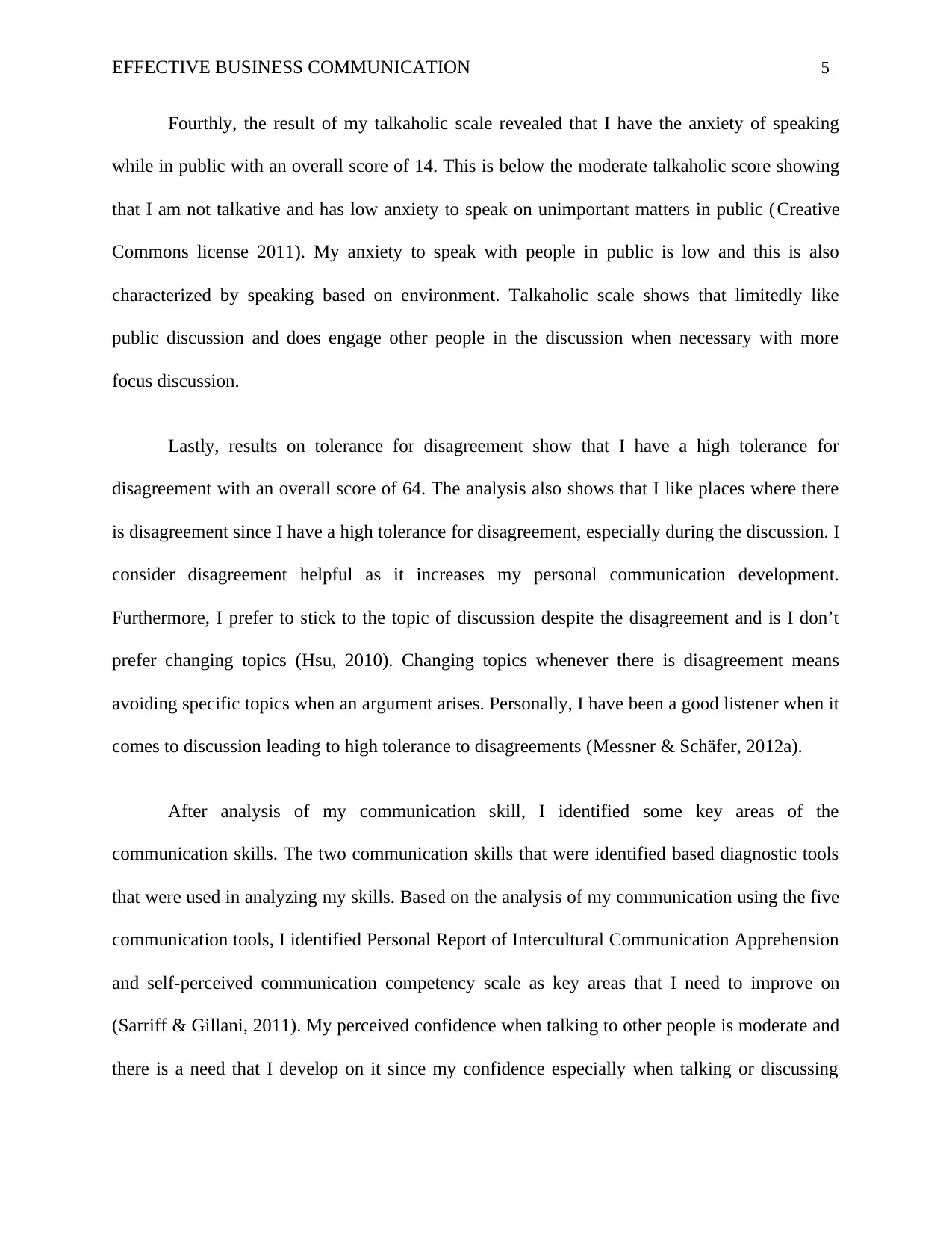
EFFECTIVE BUSINESS COMMUNICATION 5
Fourthly, the result of my talkaholic scale revealed that I have the anxiety of speaking
while in public with an overall score of 14. This is below the moderate talkaholic score showing
that I am not talkative and has low anxiety to speak on unimportant matters in public (Creative
Commons license 2011). My anxiety to speak with people in public is low and this is also
characterized by speaking based on environment. Talkaholic scale shows that limitedly like
public discussion and does engage other people in the discussion when necessary with more
focus discussion.
Lastly, results on tolerance for disagreement show that I have a high tolerance for
disagreement with an overall score of 64. The analysis also shows that I like places where there
is disagreement since I have a high tolerance for disagreement, especially during the discussion. I
consider disagreement helpful as it increases my personal communication development.
Furthermore, I prefer to stick to the topic of discussion despite the disagreement and is I don’t
prefer changing topics (Hsu, 2010). Changing topics whenever there is disagreement means
avoiding specific topics when an argument arises. Personally, I have been a good listener when it
comes to discussion leading to high tolerance to disagreements (Messner & Schäfer, 2012a).
After analysis of my communication skill, I identified some key areas of the
communication skills. The two communication skills that were identified based diagnostic tools
that were used in analyzing my skills. Based on the analysis of my communication using the five
communication tools, I identified Personal Report of Intercultural Communication Apprehension
and self-perceived communication competency scale as key areas that I need to improve on
(Sarriff & Gillani, 2011). My perceived confidence when talking to other people is moderate and
there is a need that I develop on it since my confidence especially when talking or discussing
Fourthly, the result of my talkaholic scale revealed that I have the anxiety of speaking
while in public with an overall score of 14. This is below the moderate talkaholic score showing
that I am not talkative and has low anxiety to speak on unimportant matters in public (Creative
Commons license 2011). My anxiety to speak with people in public is low and this is also
characterized by speaking based on environment. Talkaholic scale shows that limitedly like
public discussion and does engage other people in the discussion when necessary with more
focus discussion.
Lastly, results on tolerance for disagreement show that I have a high tolerance for
disagreement with an overall score of 64. The analysis also shows that I like places where there
is disagreement since I have a high tolerance for disagreement, especially during the discussion. I
consider disagreement helpful as it increases my personal communication development.
Furthermore, I prefer to stick to the topic of discussion despite the disagreement and is I don’t
prefer changing topics (Hsu, 2010). Changing topics whenever there is disagreement means
avoiding specific topics when an argument arises. Personally, I have been a good listener when it
comes to discussion leading to high tolerance to disagreements (Messner & Schäfer, 2012a).
After analysis of my communication skill, I identified some key areas of the
communication skills. The two communication skills that were identified based diagnostic tools
that were used in analyzing my skills. Based on the analysis of my communication using the five
communication tools, I identified Personal Report of Intercultural Communication Apprehension
and self-perceived communication competency scale as key areas that I need to improve on
(Sarriff & Gillani, 2011). My perceived confidence when talking to other people is moderate and
there is a need that I develop on it since my confidence especially when talking or discussing
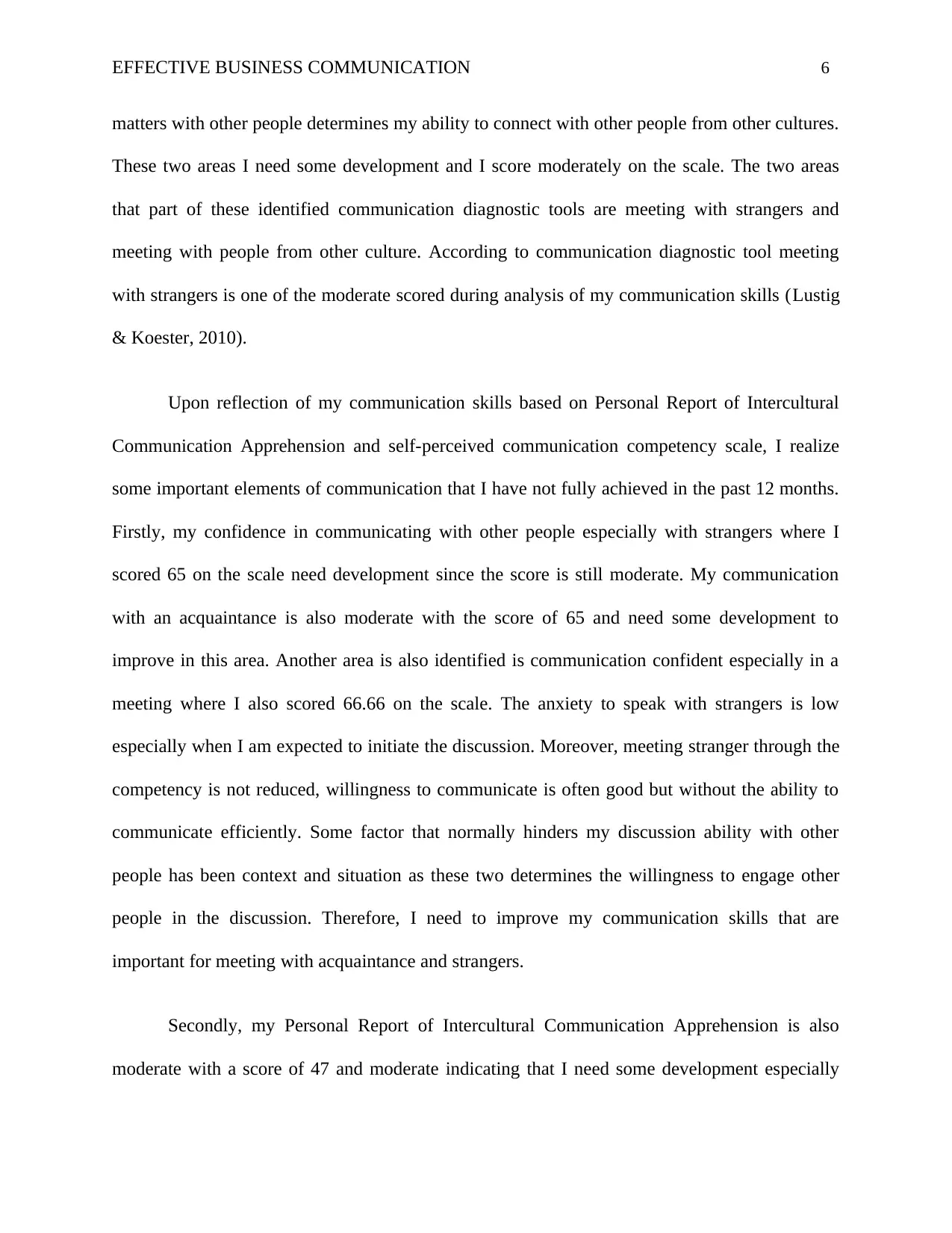
EFFECTIVE BUSINESS COMMUNICATION 6
matters with other people determines my ability to connect with other people from other cultures.
These two areas I need some development and I score moderately on the scale. The two areas
that part of these identified communication diagnostic tools are meeting with strangers and
meeting with people from other culture. According to communication diagnostic tool meeting
with strangers is one of the moderate scored during analysis of my communication skills (Lustig
& Koester, 2010).
Upon reflection of my communication skills based on Personal Report of Intercultural
Communication Apprehension and self-perceived communication competency scale, I realize
some important elements of communication that I have not fully achieved in the past 12 months.
Firstly, my confidence in communicating with other people especially with strangers where I
scored 65 on the scale need development since the score is still moderate. My communication
with an acquaintance is also moderate with the score of 65 and need some development to
improve in this area. Another area is also identified is communication confident especially in a
meeting where I also scored 66.66 on the scale. The anxiety to speak with strangers is low
especially when I am expected to initiate the discussion. Moreover, meeting stranger through the
competency is not reduced, willingness to communicate is often good but without the ability to
communicate efficiently. Some factor that normally hinders my discussion ability with other
people has been context and situation as these two determines the willingness to engage other
people in the discussion. Therefore, I need to improve my communication skills that are
important for meeting with acquaintance and strangers.
Secondly, my Personal Report of Intercultural Communication Apprehension is also
moderate with a score of 47 and moderate indicating that I need some development especially
matters with other people determines my ability to connect with other people from other cultures.
These two areas I need some development and I score moderately on the scale. The two areas
that part of these identified communication diagnostic tools are meeting with strangers and
meeting with people from other culture. According to communication diagnostic tool meeting
with strangers is one of the moderate scored during analysis of my communication skills (Lustig
& Koester, 2010).
Upon reflection of my communication skills based on Personal Report of Intercultural
Communication Apprehension and self-perceived communication competency scale, I realize
some important elements of communication that I have not fully achieved in the past 12 months.
Firstly, my confidence in communicating with other people especially with strangers where I
scored 65 on the scale need development since the score is still moderate. My communication
with an acquaintance is also moderate with the score of 65 and need some development to
improve in this area. Another area is also identified is communication confident especially in a
meeting where I also scored 66.66 on the scale. The anxiety to speak with strangers is low
especially when I am expected to initiate the discussion. Moreover, meeting stranger through the
competency is not reduced, willingness to communicate is often good but without the ability to
communicate efficiently. Some factor that normally hinders my discussion ability with other
people has been context and situation as these two determines the willingness to engage other
people in the discussion. Therefore, I need to improve my communication skills that are
important for meeting with acquaintance and strangers.
Secondly, my Personal Report of Intercultural Communication Apprehension is also
moderate with a score of 47 and moderate indicating that I need some development especially
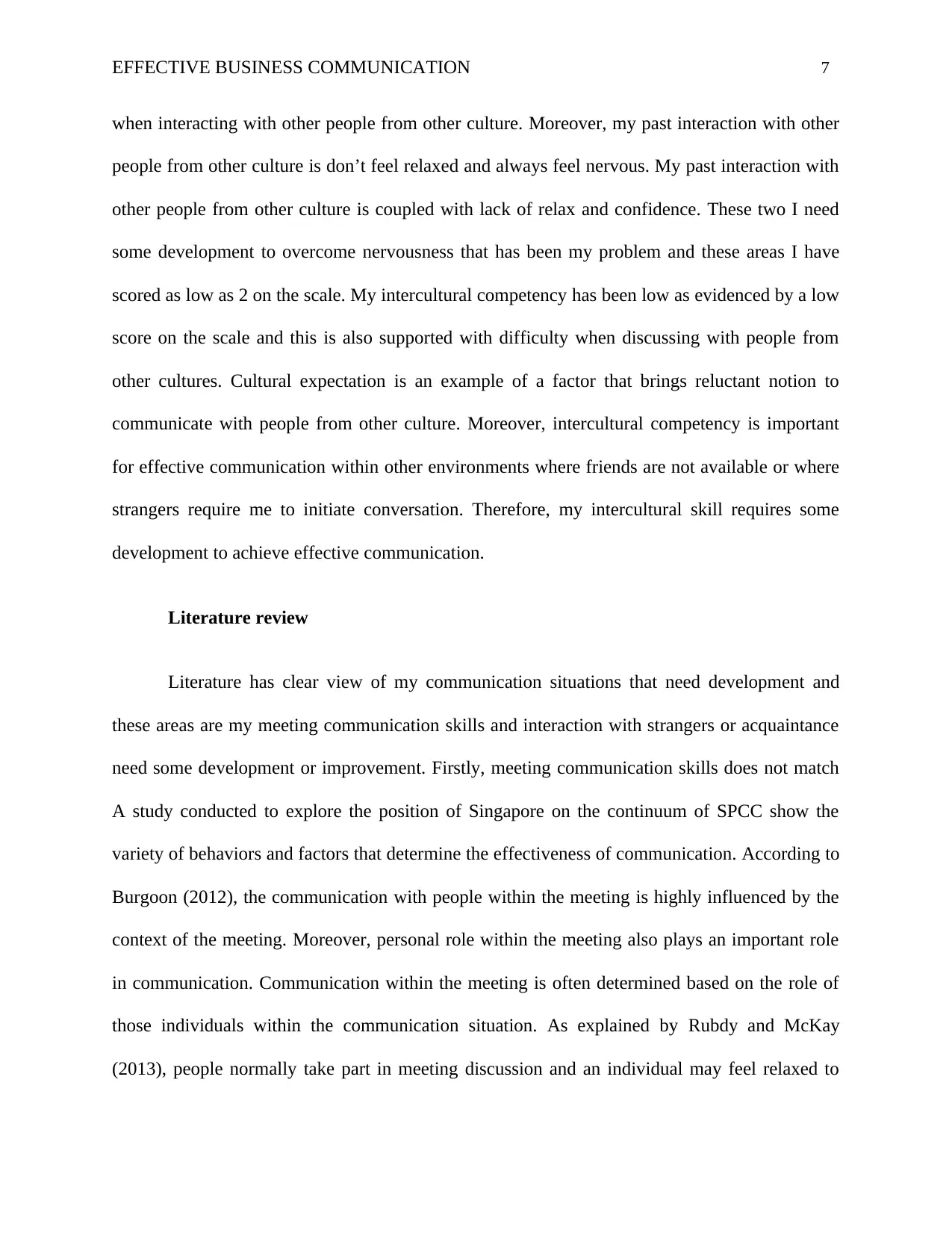
EFFECTIVE BUSINESS COMMUNICATION 7
when interacting with other people from other culture. Moreover, my past interaction with other
people from other culture is don’t feel relaxed and always feel nervous. My past interaction with
other people from other culture is coupled with lack of relax and confidence. These two I need
some development to overcome nervousness that has been my problem and these areas I have
scored as low as 2 on the scale. My intercultural competency has been low as evidenced by a low
score on the scale and this is also supported with difficulty when discussing with people from
other cultures. Cultural expectation is an example of a factor that brings reluctant notion to
communicate with people from other culture. Moreover, intercultural competency is important
for effective communication within other environments where friends are not available or where
strangers require me to initiate conversation. Therefore, my intercultural skill requires some
development to achieve effective communication.
Literature review
Literature has clear view of my communication situations that need development and
these areas are my meeting communication skills and interaction with strangers or acquaintance
need some development or improvement. Firstly, meeting communication skills does not match
A study conducted to explore the position of Singapore on the continuum of SPCC show the
variety of behaviors and factors that determine the effectiveness of communication. According to
Burgoon (2012), the communication with people within the meeting is highly influenced by the
context of the meeting. Moreover, personal role within the meeting also plays an important role
in communication. Communication within the meeting is often determined based on the role of
those individuals within the communication situation. As explained by Rubdy and McKay
(2013), people normally take part in meeting discussion and an individual may feel relaxed to
when interacting with other people from other culture. Moreover, my past interaction with other
people from other culture is don’t feel relaxed and always feel nervous. My past interaction with
other people from other culture is coupled with lack of relax and confidence. These two I need
some development to overcome nervousness that has been my problem and these areas I have
scored as low as 2 on the scale. My intercultural competency has been low as evidenced by a low
score on the scale and this is also supported with difficulty when discussing with people from
other cultures. Cultural expectation is an example of a factor that brings reluctant notion to
communicate with people from other culture. Moreover, intercultural competency is important
for effective communication within other environments where friends are not available or where
strangers require me to initiate conversation. Therefore, my intercultural skill requires some
development to achieve effective communication.
Literature review
Literature has clear view of my communication situations that need development and
these areas are my meeting communication skills and interaction with strangers or acquaintance
need some development or improvement. Firstly, meeting communication skills does not match
A study conducted to explore the position of Singapore on the continuum of SPCC show the
variety of behaviors and factors that determine the effectiveness of communication. According to
Burgoon (2012), the communication with people within the meeting is highly influenced by the
context of the meeting. Moreover, personal role within the meeting also plays an important role
in communication. Communication within the meeting is often determined based on the role of
those individuals within the communication situation. As explained by Rubdy and McKay
(2013), people normally take part in meeting discussion and an individual may feel relaxed to
Paraphrase This Document
Need a fresh take? Get an instant paraphrase of this document with our AI Paraphraser
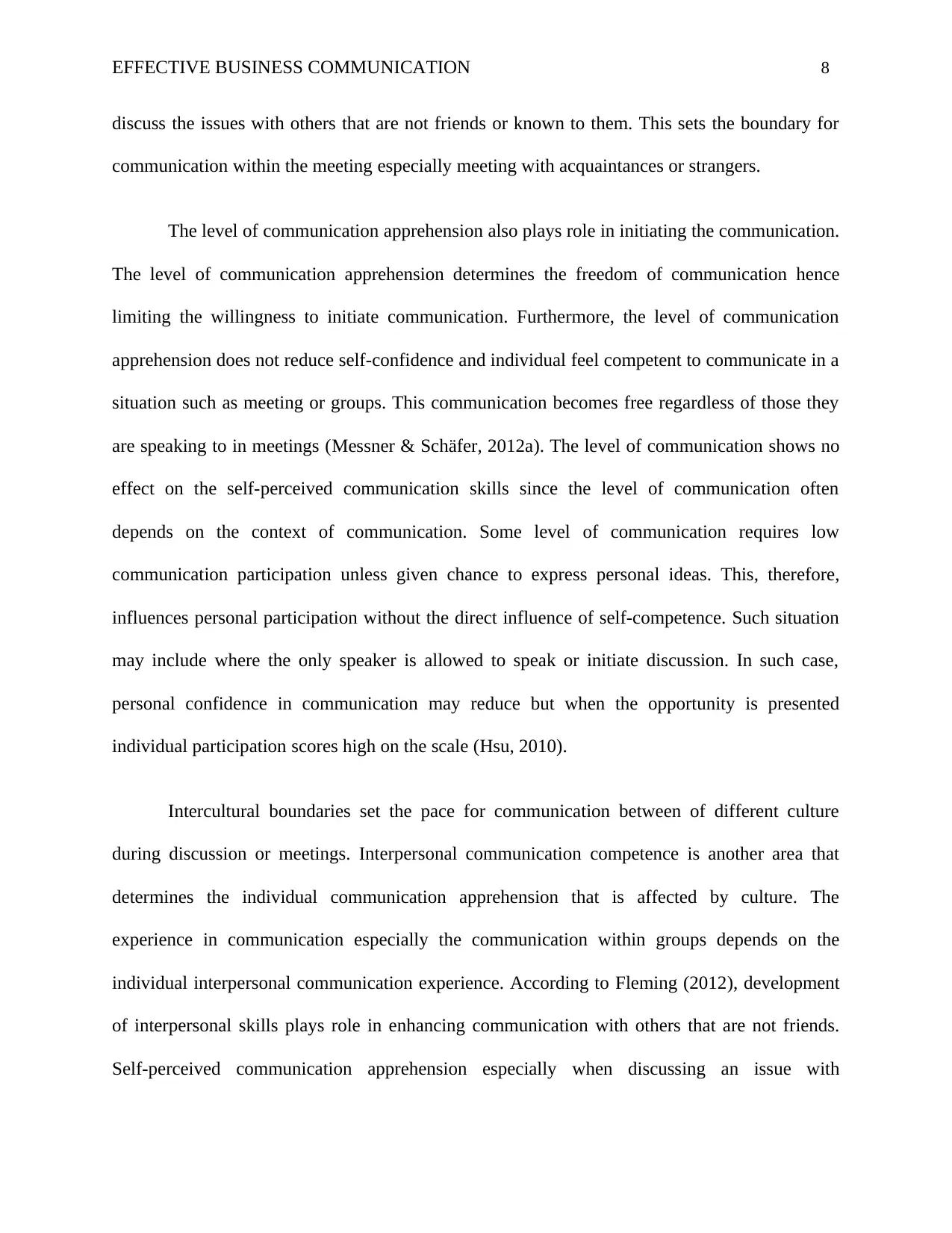
EFFECTIVE BUSINESS COMMUNICATION 8
discuss the issues with others that are not friends or known to them. This sets the boundary for
communication within the meeting especially meeting with acquaintances or strangers.
The level of communication apprehension also plays role in initiating the communication.
The level of communication apprehension determines the freedom of communication hence
limiting the willingness to initiate communication. Furthermore, the level of communication
apprehension does not reduce self-confidence and individual feel competent to communicate in a
situation such as meeting or groups. This communication becomes free regardless of those they
are speaking to in meetings (Messner & Schäfer, 2012a). The level of communication shows no
effect on the self-perceived communication skills since the level of communication often
depends on the context of communication. Some level of communication requires low
communication participation unless given chance to express personal ideas. This, therefore,
influences personal participation without the direct influence of self-competence. Such situation
may include where the only speaker is allowed to speak or initiate discussion. In such case,
personal confidence in communication may reduce but when the opportunity is presented
individual participation scores high on the scale (Hsu, 2010).
Intercultural boundaries set the pace for communication between of different culture
during discussion or meetings. Interpersonal communication competence is another area that
determines the individual communication apprehension that is affected by culture. The
experience in communication especially the communication within groups depends on the
individual interpersonal communication experience. According to Fleming (2012), development
of interpersonal skills plays role in enhancing communication with others that are not friends.
Self-perceived communication apprehension especially when discussing an issue with
discuss the issues with others that are not friends or known to them. This sets the boundary for
communication within the meeting especially meeting with acquaintances or strangers.
The level of communication apprehension also plays role in initiating the communication.
The level of communication apprehension determines the freedom of communication hence
limiting the willingness to initiate communication. Furthermore, the level of communication
apprehension does not reduce self-confidence and individual feel competent to communicate in a
situation such as meeting or groups. This communication becomes free regardless of those they
are speaking to in meetings (Messner & Schäfer, 2012a). The level of communication shows no
effect on the self-perceived communication skills since the level of communication often
depends on the context of communication. Some level of communication requires low
communication participation unless given chance to express personal ideas. This, therefore,
influences personal participation without the direct influence of self-competence. Such situation
may include where the only speaker is allowed to speak or initiate discussion. In such case,
personal confidence in communication may reduce but when the opportunity is presented
individual participation scores high on the scale (Hsu, 2010).
Intercultural boundaries set the pace for communication between of different culture
during discussion or meetings. Interpersonal communication competence is another area that
determines the individual communication apprehension that is affected by culture. The
experience in communication especially the communication within groups depends on the
individual interpersonal communication experience. According to Fleming (2012), development
of interpersonal skills plays role in enhancing communication with others that are not friends.
Self-perceived communication apprehension especially when discussing an issue with
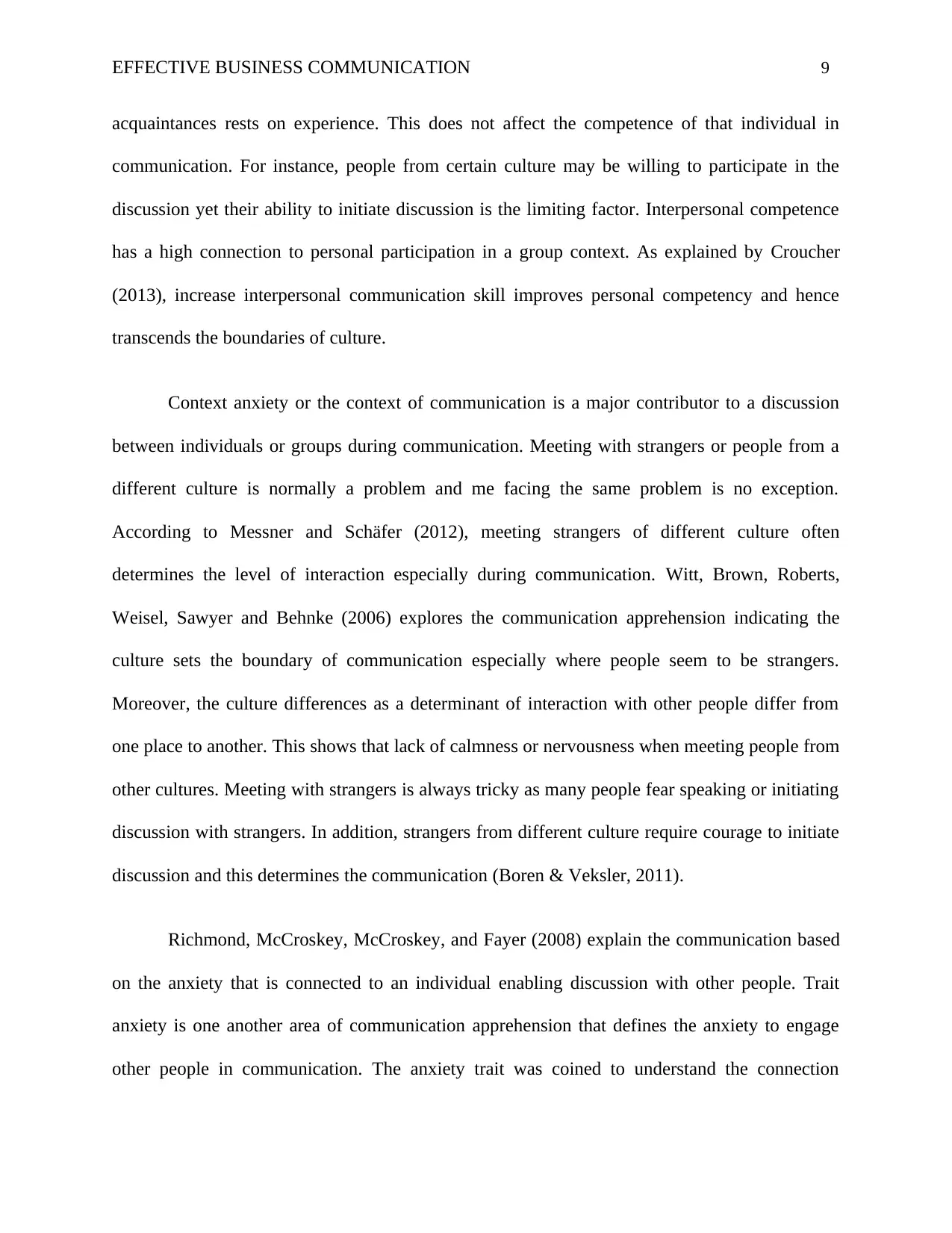
EFFECTIVE BUSINESS COMMUNICATION 9
acquaintances rests on experience. This does not affect the competence of that individual in
communication. For instance, people from certain culture may be willing to participate in the
discussion yet their ability to initiate discussion is the limiting factor. Interpersonal competence
has a high connection to personal participation in a group context. As explained by Croucher
(2013), increase interpersonal communication skill improves personal competency and hence
transcends the boundaries of culture.
Context anxiety or the context of communication is a major contributor to a discussion
between individuals or groups during communication. Meeting with strangers or people from a
different culture is normally a problem and me facing the same problem is no exception.
According to Messner and Schäfer (2012), meeting strangers of different culture often
determines the level of interaction especially during communication. Witt, Brown, Roberts,
Weisel, Sawyer and Behnke (2006) explores the communication apprehension indicating the
culture sets the boundary of communication especially where people seem to be strangers.
Moreover, the culture differences as a determinant of interaction with other people differ from
one place to another. This shows that lack of calmness or nervousness when meeting people from
other cultures. Meeting with strangers is always tricky as many people fear speaking or initiating
discussion with strangers. In addition, strangers from different culture require courage to initiate
discussion and this determines the communication (Boren & Veksler, 2011).
Richmond, McCroskey, McCroskey, and Fayer (2008) explain the communication based
on the anxiety that is connected to an individual enabling discussion with other people. Trait
anxiety is one another area of communication apprehension that defines the anxiety to engage
other people in communication. The anxiety trait was coined to understand the connection
acquaintances rests on experience. This does not affect the competence of that individual in
communication. For instance, people from certain culture may be willing to participate in the
discussion yet their ability to initiate discussion is the limiting factor. Interpersonal competence
has a high connection to personal participation in a group context. As explained by Croucher
(2013), increase interpersonal communication skill improves personal competency and hence
transcends the boundaries of culture.
Context anxiety or the context of communication is a major contributor to a discussion
between individuals or groups during communication. Meeting with strangers or people from a
different culture is normally a problem and me facing the same problem is no exception.
According to Messner and Schäfer (2012), meeting strangers of different culture often
determines the level of interaction especially during communication. Witt, Brown, Roberts,
Weisel, Sawyer and Behnke (2006) explores the communication apprehension indicating the
culture sets the boundary of communication especially where people seem to be strangers.
Moreover, the culture differences as a determinant of interaction with other people differ from
one place to another. This shows that lack of calmness or nervousness when meeting people from
other cultures. Meeting with strangers is always tricky as many people fear speaking or initiating
discussion with strangers. In addition, strangers from different culture require courage to initiate
discussion and this determines the communication (Boren & Veksler, 2011).
Richmond, McCroskey, McCroskey, and Fayer (2008) explain the communication based
on the anxiety that is connected to an individual enabling discussion with other people. Trait
anxiety is one another area of communication apprehension that defines the anxiety to engage
other people in communication. The anxiety trait was coined to understand the connection
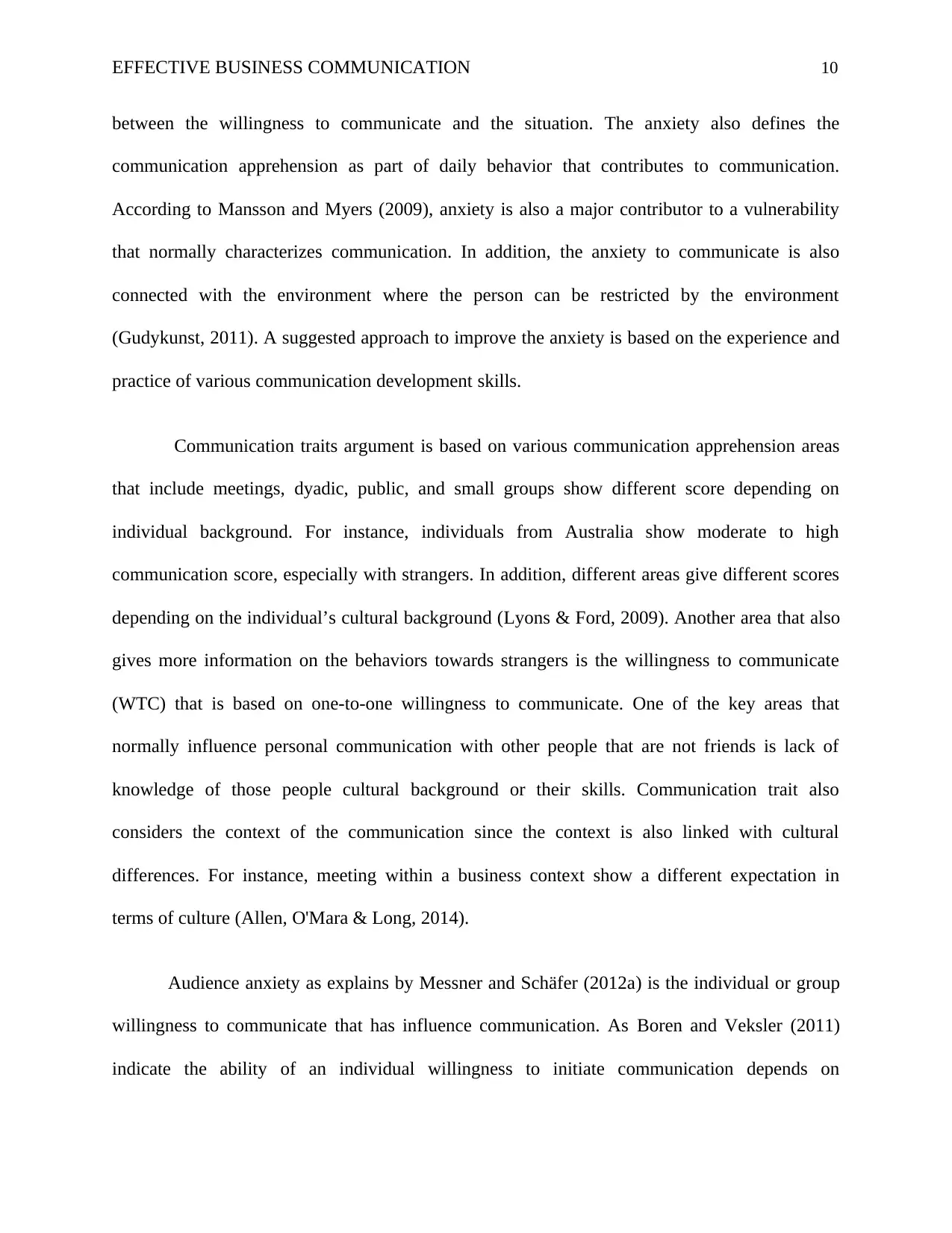
EFFECTIVE BUSINESS COMMUNICATION 10
between the willingness to communicate and the situation. The anxiety also defines the
communication apprehension as part of daily behavior that contributes to communication.
According to Mansson and Myers (2009), anxiety is also a major contributor to a vulnerability
that normally characterizes communication. In addition, the anxiety to communicate is also
connected with the environment where the person can be restricted by the environment
(Gudykunst, 2011). A suggested approach to improve the anxiety is based on the experience and
practice of various communication development skills.
Communication traits argument is based on various communication apprehension areas
that include meetings, dyadic, public, and small groups show different score depending on
individual background. For instance, individuals from Australia show moderate to high
communication score, especially with strangers. In addition, different areas give different scores
depending on the individual’s cultural background (Lyons & Ford, 2009). Another area that also
gives more information on the behaviors towards strangers is the willingness to communicate
(WTC) that is based on one-to-one willingness to communicate. One of the key areas that
normally influence personal communication with other people that are not friends is lack of
knowledge of those people cultural background or their skills. Communication trait also
considers the context of the communication since the context is also linked with cultural
differences. For instance, meeting within a business context show a different expectation in
terms of culture (Allen, O'Mara & Long, 2014).
Audience anxiety as explains by Messner and Schäfer (2012a) is the individual or group
willingness to communicate that has influence communication. As Boren and Veksler (2011)
indicate the ability of an individual willingness to initiate communication depends on
between the willingness to communicate and the situation. The anxiety also defines the
communication apprehension as part of daily behavior that contributes to communication.
According to Mansson and Myers (2009), anxiety is also a major contributor to a vulnerability
that normally characterizes communication. In addition, the anxiety to communicate is also
connected with the environment where the person can be restricted by the environment
(Gudykunst, 2011). A suggested approach to improve the anxiety is based on the experience and
practice of various communication development skills.
Communication traits argument is based on various communication apprehension areas
that include meetings, dyadic, public, and small groups show different score depending on
individual background. For instance, individuals from Australia show moderate to high
communication score, especially with strangers. In addition, different areas give different scores
depending on the individual’s cultural background (Lyons & Ford, 2009). Another area that also
gives more information on the behaviors towards strangers is the willingness to communicate
(WTC) that is based on one-to-one willingness to communicate. One of the key areas that
normally influence personal communication with other people that are not friends is lack of
knowledge of those people cultural background or their skills. Communication trait also
considers the context of the communication since the context is also linked with cultural
differences. For instance, meeting within a business context show a different expectation in
terms of culture (Allen, O'Mara & Long, 2014).
Audience anxiety as explains by Messner and Schäfer (2012a) is the individual or group
willingness to communicate that has influence communication. As Boren and Veksler (2011)
indicate the ability of an individual willingness to initiate communication depends on
Secure Best Marks with AI Grader
Need help grading? Try our AI Grader for instant feedback on your assignments.
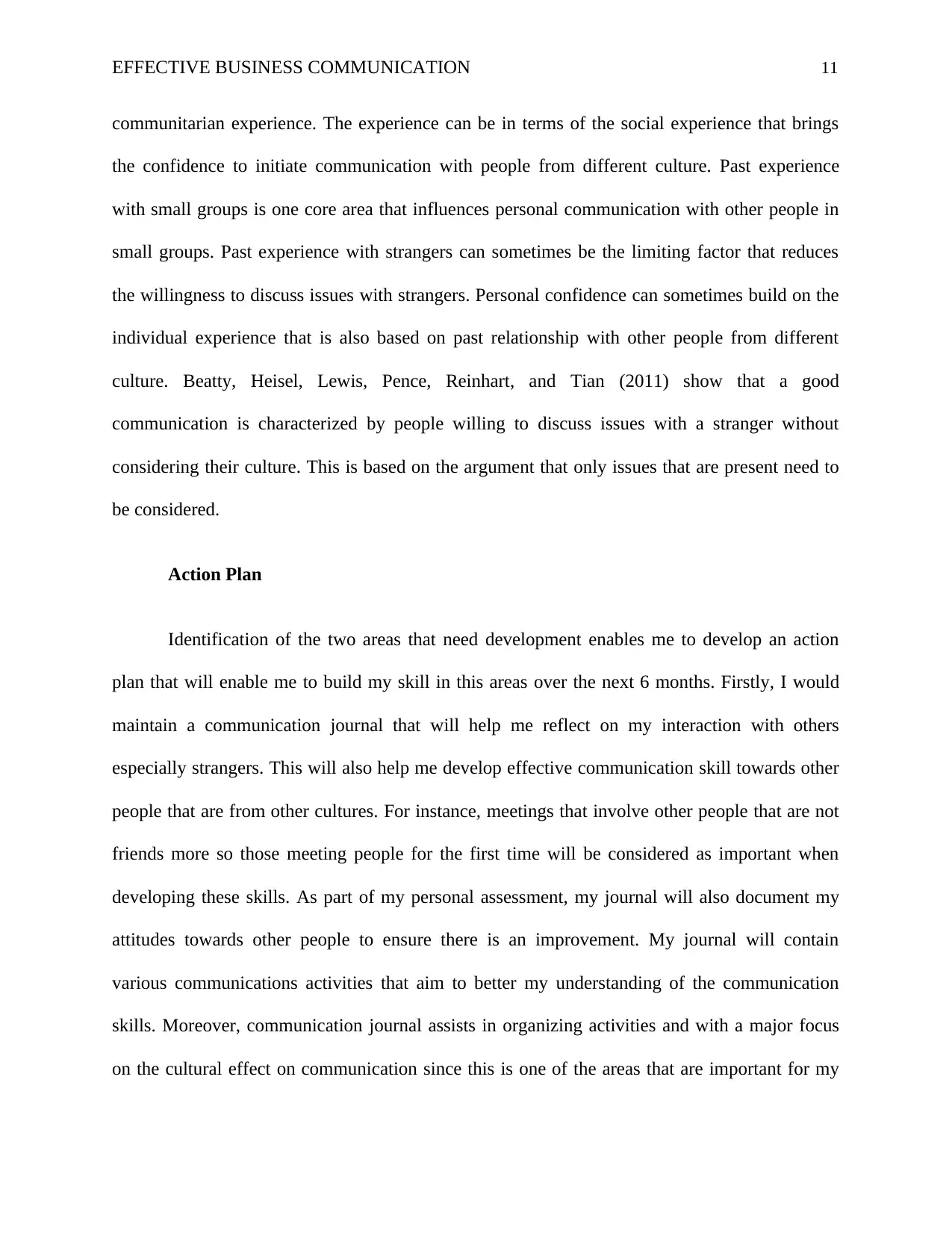
EFFECTIVE BUSINESS COMMUNICATION 11
communitarian experience. The experience can be in terms of the social experience that brings
the confidence to initiate communication with people from different culture. Past experience
with small groups is one core area that influences personal communication with other people in
small groups. Past experience with strangers can sometimes be the limiting factor that reduces
the willingness to discuss issues with strangers. Personal confidence can sometimes build on the
individual experience that is also based on past relationship with other people from different
culture. Beatty, Heisel, Lewis, Pence, Reinhart, and Tian (2011) show that a good
communication is characterized by people willing to discuss issues with a stranger without
considering their culture. This is based on the argument that only issues that are present need to
be considered.
Action Plan
Identification of the two areas that need development enables me to develop an action
plan that will enable me to build my skill in this areas over the next 6 months. Firstly, I would
maintain a communication journal that will help me reflect on my interaction with others
especially strangers. This will also help me develop effective communication skill towards other
people that are from other cultures. For instance, meetings that involve other people that are not
friends more so those meeting people for the first time will be considered as important when
developing these skills. As part of my personal assessment, my journal will also document my
attitudes towards other people to ensure there is an improvement. My journal will contain
various communications activities that aim to better my understanding of the communication
skills. Moreover, communication journal assists in organizing activities and with a major focus
on the cultural effect on communication since this is one of the areas that are important for my
communitarian experience. The experience can be in terms of the social experience that brings
the confidence to initiate communication with people from different culture. Past experience
with small groups is one core area that influences personal communication with other people in
small groups. Past experience with strangers can sometimes be the limiting factor that reduces
the willingness to discuss issues with strangers. Personal confidence can sometimes build on the
individual experience that is also based on past relationship with other people from different
culture. Beatty, Heisel, Lewis, Pence, Reinhart, and Tian (2011) show that a good
communication is characterized by people willing to discuss issues with a stranger without
considering their culture. This is based on the argument that only issues that are present need to
be considered.
Action Plan
Identification of the two areas that need development enables me to develop an action
plan that will enable me to build my skill in this areas over the next 6 months. Firstly, I would
maintain a communication journal that will help me reflect on my interaction with others
especially strangers. This will also help me develop effective communication skill towards other
people that are from other cultures. For instance, meetings that involve other people that are not
friends more so those meeting people for the first time will be considered as important when
developing these skills. As part of my personal assessment, my journal will also document my
attitudes towards other people to ensure there is an improvement. My journal will contain
various communications activities that aim to better my understanding of the communication
skills. Moreover, communication journal assists in organizing activities and with a major focus
on the cultural effect on communication since this is one of the areas that are important for my
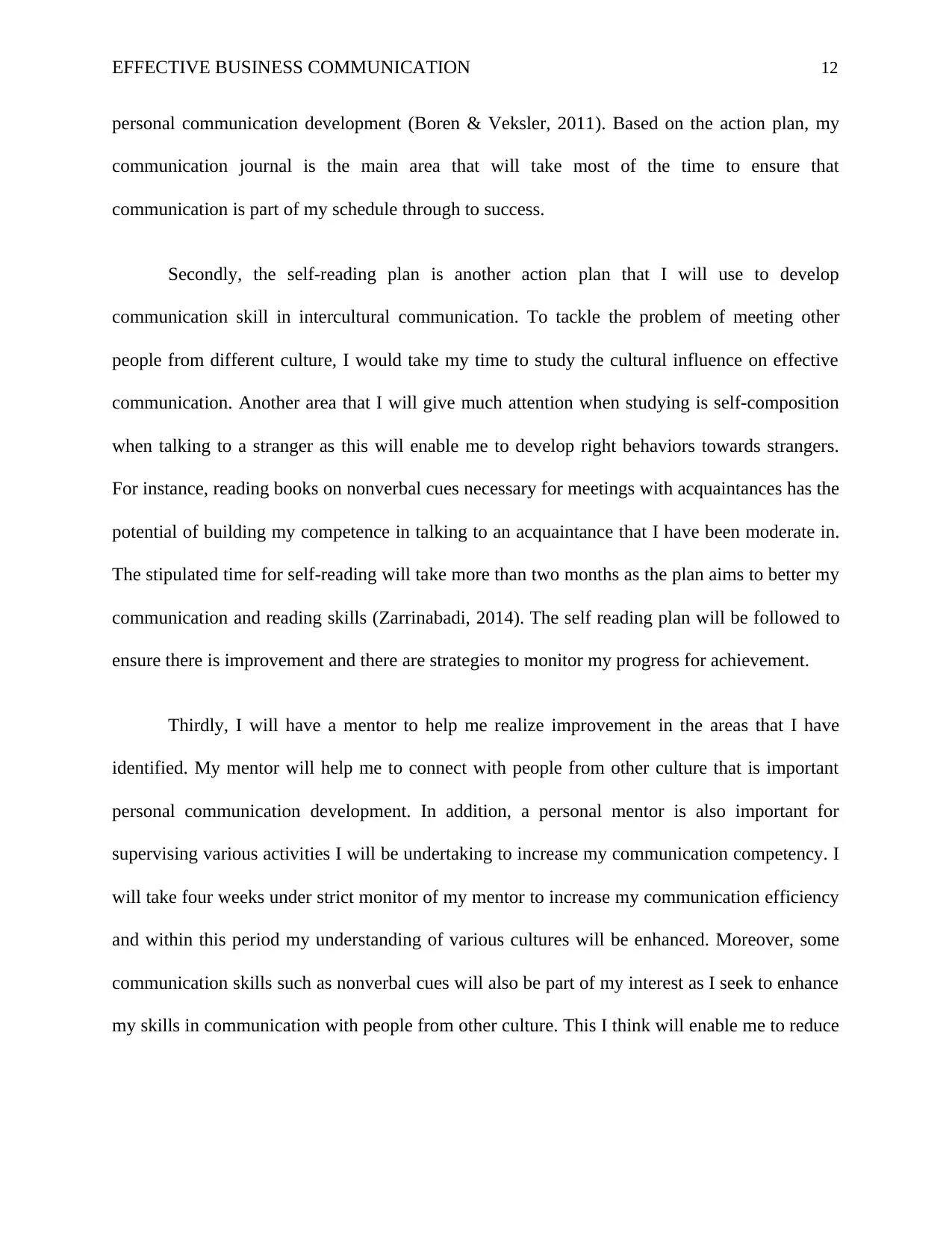
EFFECTIVE BUSINESS COMMUNICATION 12
personal communication development (Boren & Veksler, 2011). Based on the action plan, my
communication journal is the main area that will take most of the time to ensure that
communication is part of my schedule through to success.
Secondly, the self-reading plan is another action plan that I will use to develop
communication skill in intercultural communication. To tackle the problem of meeting other
people from different culture, I would take my time to study the cultural influence on effective
communication. Another area that I will give much attention when studying is self-composition
when talking to a stranger as this will enable me to develop right behaviors towards strangers.
For instance, reading books on nonverbal cues necessary for meetings with acquaintances has the
potential of building my competence in talking to an acquaintance that I have been moderate in.
The stipulated time for self-reading will take more than two months as the plan aims to better my
communication and reading skills (Zarrinabadi, 2014). The self reading plan will be followed to
ensure there is improvement and there are strategies to monitor my progress for achievement.
Thirdly, I will have a mentor to help me realize improvement in the areas that I have
identified. My mentor will help me to connect with people from other culture that is important
personal communication development. In addition, a personal mentor is also important for
supervising various activities I will be undertaking to increase my communication competency. I
will take four weeks under strict monitor of my mentor to increase my communication efficiency
and within this period my understanding of various cultures will be enhanced. Moreover, some
communication skills such as nonverbal cues will also be part of my interest as I seek to enhance
my skills in communication with people from other culture. This I think will enable me to reduce
personal communication development (Boren & Veksler, 2011). Based on the action plan, my
communication journal is the main area that will take most of the time to ensure that
communication is part of my schedule through to success.
Secondly, the self-reading plan is another action plan that I will use to develop
communication skill in intercultural communication. To tackle the problem of meeting other
people from different culture, I would take my time to study the cultural influence on effective
communication. Another area that I will give much attention when studying is self-composition
when talking to a stranger as this will enable me to develop right behaviors towards strangers.
For instance, reading books on nonverbal cues necessary for meetings with acquaintances has the
potential of building my competence in talking to an acquaintance that I have been moderate in.
The stipulated time for self-reading will take more than two months as the plan aims to better my
communication and reading skills (Zarrinabadi, 2014). The self reading plan will be followed to
ensure there is improvement and there are strategies to monitor my progress for achievement.
Thirdly, I will have a mentor to help me realize improvement in the areas that I have
identified. My mentor will help me to connect with people from other culture that is important
personal communication development. In addition, a personal mentor is also important for
supervising various activities I will be undertaking to increase my communication competency. I
will take four weeks under strict monitor of my mentor to increase my communication efficiency
and within this period my understanding of various cultures will be enhanced. Moreover, some
communication skills such as nonverbal cues will also be part of my interest as I seek to enhance
my skills in communication with people from other culture. This I think will enable me to reduce
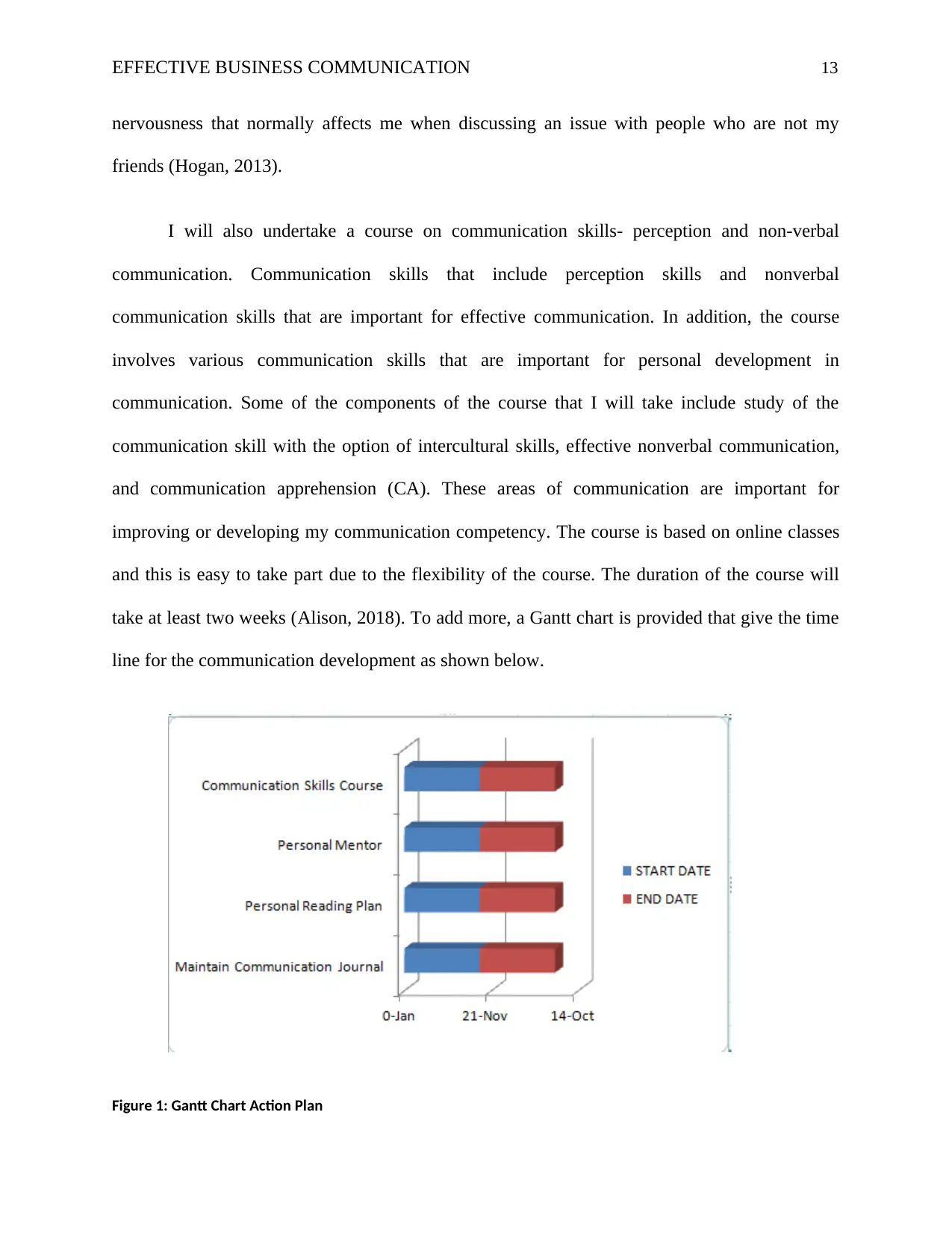
EFFECTIVE BUSINESS COMMUNICATION 13
nervousness that normally affects me when discussing an issue with people who are not my
friends (Hogan, 2013).
I will also undertake a course on communication skills- perception and non-verbal
communication. Communication skills that include perception skills and nonverbal
communication skills that are important for effective communication. In addition, the course
involves various communication skills that are important for personal development in
communication. Some of the components of the course that I will take include study of the
communication skill with the option of intercultural skills, effective nonverbal communication,
and communication apprehension (CA). These areas of communication are important for
improving or developing my communication competency. The course is based on online classes
and this is easy to take part due to the flexibility of the course. The duration of the course will
take at least two weeks (Alison, 2018). To add more, a Gantt chart is provided that give the time
line for the communication development as shown below.
Figure 1: Gantt Chart Action Plan
nervousness that normally affects me when discussing an issue with people who are not my
friends (Hogan, 2013).
I will also undertake a course on communication skills- perception and non-verbal
communication. Communication skills that include perception skills and nonverbal
communication skills that are important for effective communication. In addition, the course
involves various communication skills that are important for personal development in
communication. Some of the components of the course that I will take include study of the
communication skill with the option of intercultural skills, effective nonverbal communication,
and communication apprehension (CA). These areas of communication are important for
improving or developing my communication competency. The course is based on online classes
and this is easy to take part due to the flexibility of the course. The duration of the course will
take at least two weeks (Alison, 2018). To add more, a Gantt chart is provided that give the time
line for the communication development as shown below.
Figure 1: Gantt Chart Action Plan
Paraphrase This Document
Need a fresh take? Get an instant paraphrase of this document with our AI Paraphraser
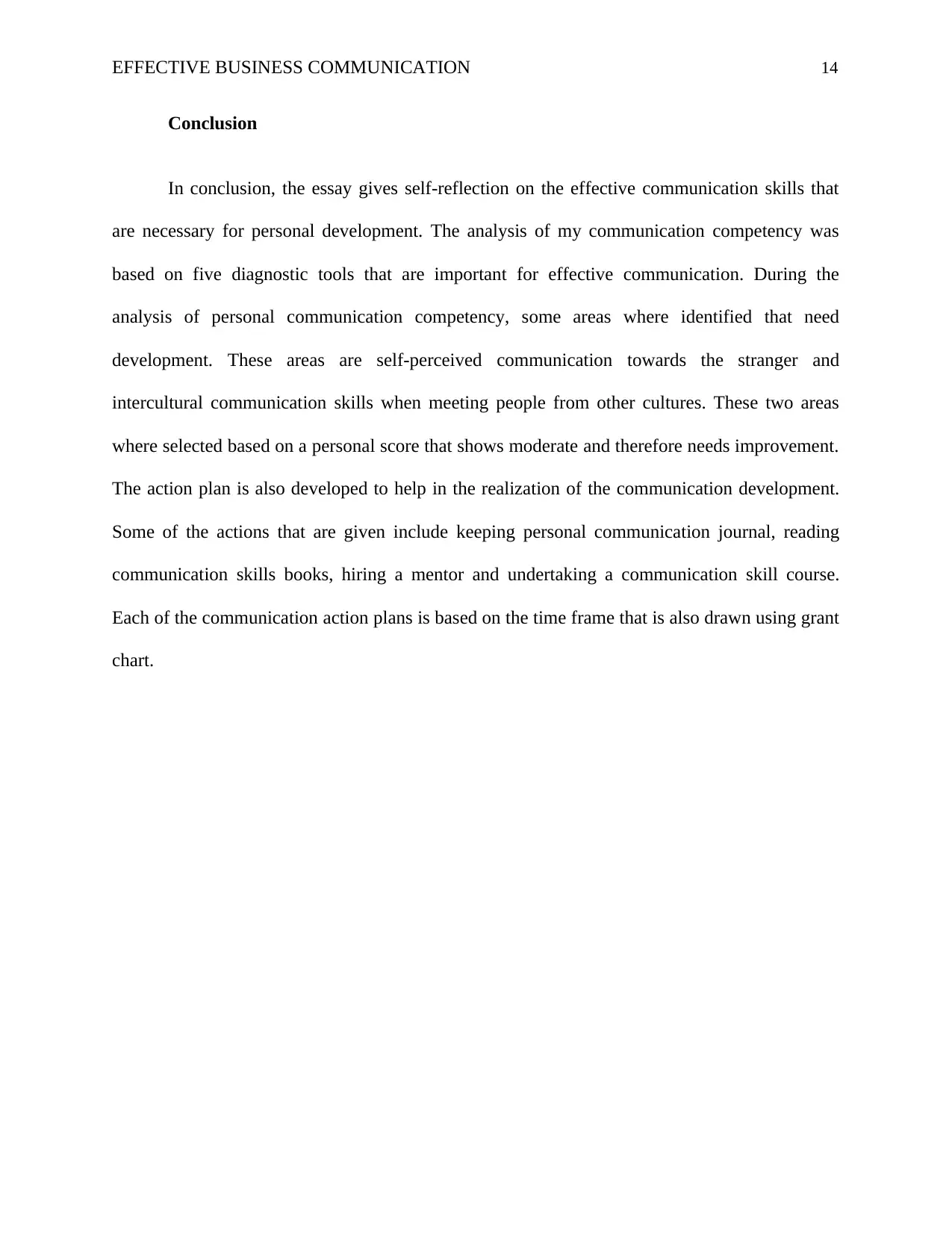
EFFECTIVE BUSINESS COMMUNICATION 14
Conclusion
In conclusion, the essay gives self-reflection on the effective communication skills that
are necessary for personal development. The analysis of my communication competency was
based on five diagnostic tools that are important for effective communication. During the
analysis of personal communication competency, some areas where identified that need
development. These areas are self-perceived communication towards the stranger and
intercultural communication skills when meeting people from other cultures. These two areas
where selected based on a personal score that shows moderate and therefore needs improvement.
The action plan is also developed to help in the realization of the communication development.
Some of the actions that are given include keeping personal communication journal, reading
communication skills books, hiring a mentor and undertaking a communication skill course.
Each of the communication action plans is based on the time frame that is also drawn using grant
chart.
Conclusion
In conclusion, the essay gives self-reflection on the effective communication skills that
are necessary for personal development. The analysis of my communication competency was
based on five diagnostic tools that are important for effective communication. During the
analysis of personal communication competency, some areas where identified that need
development. These areas are self-perceived communication towards the stranger and
intercultural communication skills when meeting people from other cultures. These two areas
where selected based on a personal score that shows moderate and therefore needs improvement.
The action plan is also developed to help in the realization of the communication development.
Some of the actions that are given include keeping personal communication journal, reading
communication skills books, hiring a mentor and undertaking a communication skill course.
Each of the communication action plans is based on the time frame that is also drawn using grant
chart.
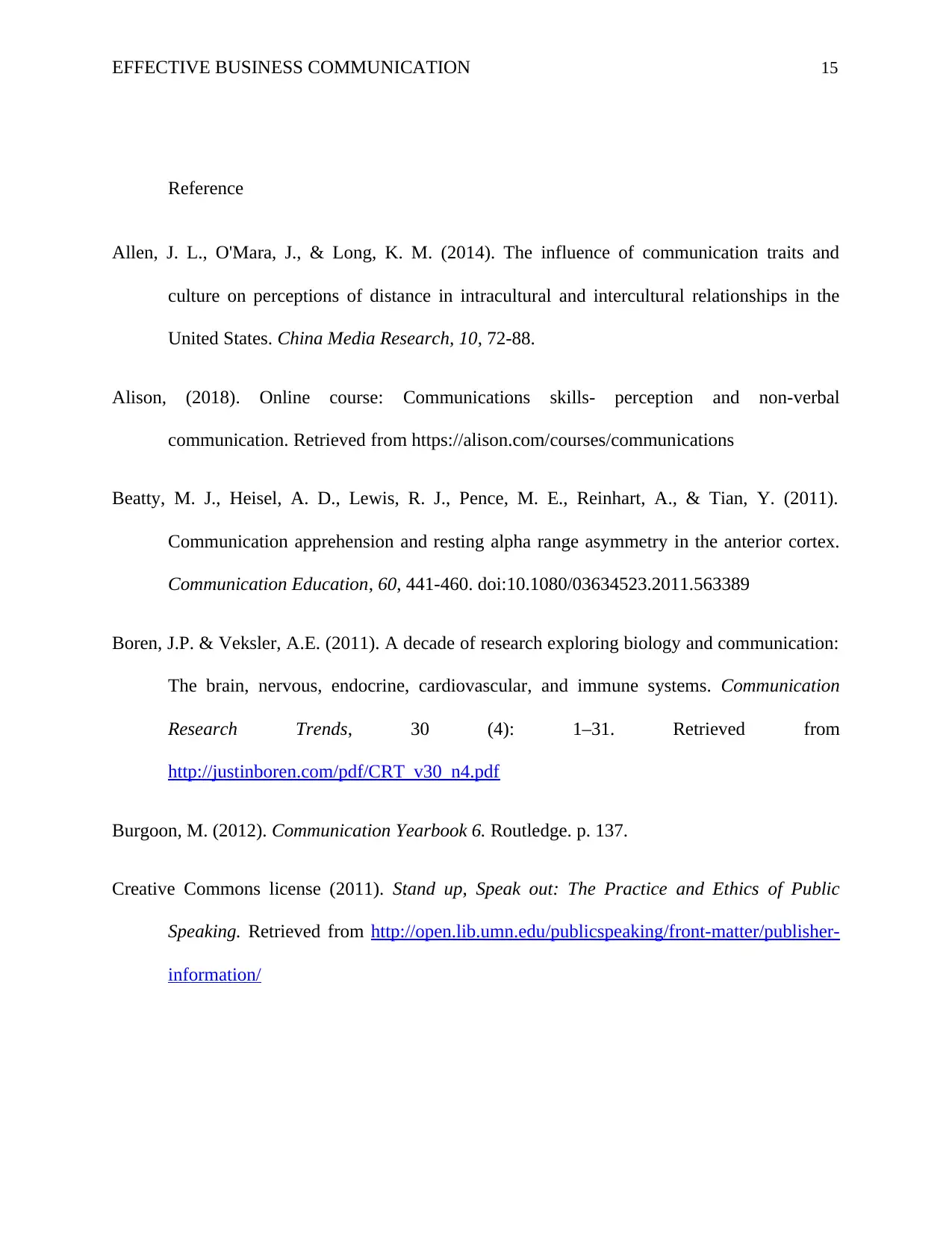
EFFECTIVE BUSINESS COMMUNICATION 15
Reference
Allen, J. L., O'Mara, J., & Long, K. M. (2014). The influence of communication traits and
culture on perceptions of distance in intracultural and intercultural relationships in the
United States. China Media Research, 10, 72-88.
Alison, (2018). Online course: Communications skills- perception and non-verbal
communication. Retrieved from https://alison.com/courses/communications
Beatty, M. J., Heisel, A. D., Lewis, R. J., Pence, M. E., Reinhart, A., & Tian, Y. (2011).
Communication apprehension and resting alpha range asymmetry in the anterior cortex.
Communication Education, 60, 441-460. doi:10.1080/03634523.2011.563389
Boren, J.P. & Veksler, A.E. (2011). A decade of research exploring biology and communication:
The brain, nervous, endocrine, cardiovascular, and immune systems. Communication
Research Trends, 30 (4): 1–31. Retrieved from
http://justinboren.com/pdf/CRT_v30_n4.pdf
Burgoon, M. (2012). Communication Yearbook 6. Routledge. p. 137.
Creative Commons license (2011). Stand up, Speak out: The Practice and Ethics of Public
Speaking. Retrieved from http://open.lib.umn.edu/publicspeaking/front-matter/publisher-
information/
Reference
Allen, J. L., O'Mara, J., & Long, K. M. (2014). The influence of communication traits and
culture on perceptions of distance in intracultural and intercultural relationships in the
United States. China Media Research, 10, 72-88.
Alison, (2018). Online course: Communications skills- perception and non-verbal
communication. Retrieved from https://alison.com/courses/communications
Beatty, M. J., Heisel, A. D., Lewis, R. J., Pence, M. E., Reinhart, A., & Tian, Y. (2011).
Communication apprehension and resting alpha range asymmetry in the anterior cortex.
Communication Education, 60, 441-460. doi:10.1080/03634523.2011.563389
Boren, J.P. & Veksler, A.E. (2011). A decade of research exploring biology and communication:
The brain, nervous, endocrine, cardiovascular, and immune systems. Communication
Research Trends, 30 (4): 1–31. Retrieved from
http://justinboren.com/pdf/CRT_v30_n4.pdf
Burgoon, M. (2012). Communication Yearbook 6. Routledge. p. 137.
Creative Commons license (2011). Stand up, Speak out: The Practice and Ethics of Public
Speaking. Retrieved from http://open.lib.umn.edu/publicspeaking/front-matter/publisher-
information/
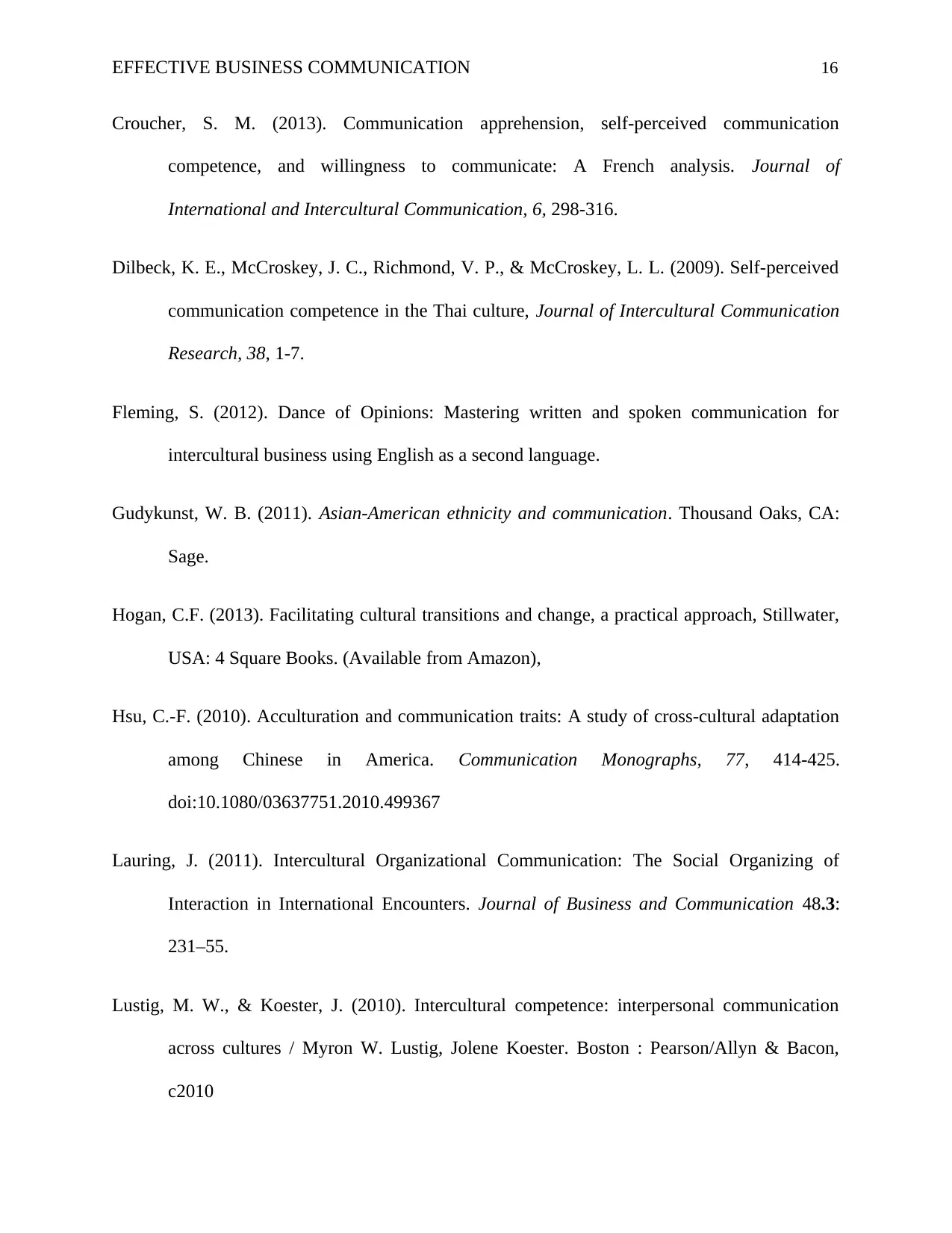
EFFECTIVE BUSINESS COMMUNICATION 16
Croucher, S. M. (2013). Communication apprehension, self-perceived communication
competence, and willingness to communicate: A French analysis. Journal of
International and Intercultural Communication, 6, 298-316.
Dilbeck, K. E., McCroskey, J. C., Richmond, V. P., & McCroskey, L. L. (2009). Self-perceived
communication competence in the Thai culture, Journal of Intercultural Communication
Research, 38, 1-7.
Fleming, S. (2012). Dance of Opinions: Mastering written and spoken communication for
intercultural business using English as a second language.
Gudykunst, W. B. (2011). Asian-American ethnicity and communication. Thousand Oaks, CA:
Sage.
Hogan, C.F. (2013). Facilitating cultural transitions and change, a practical approach, Stillwater,
USA: 4 Square Books. (Available from Amazon),
Hsu, C.-F. (2010). Acculturation and communication traits: A study of cross-cultural adaptation
among Chinese in America. Communication Monographs, 77, 414-425.
doi:10.1080/03637751.2010.499367
Lauring, J. (2011). Intercultural Organizational Communication: The Social Organizing of
Interaction in International Encounters. Journal of Business and Communication 48.3:
231–55.
Lustig, M. W., & Koester, J. (2010). Intercultural competence: interpersonal communication
across cultures / Myron W. Lustig, Jolene Koester. Boston : Pearson/Allyn & Bacon,
c2010
Croucher, S. M. (2013). Communication apprehension, self-perceived communication
competence, and willingness to communicate: A French analysis. Journal of
International and Intercultural Communication, 6, 298-316.
Dilbeck, K. E., McCroskey, J. C., Richmond, V. P., & McCroskey, L. L. (2009). Self-perceived
communication competence in the Thai culture, Journal of Intercultural Communication
Research, 38, 1-7.
Fleming, S. (2012). Dance of Opinions: Mastering written and spoken communication for
intercultural business using English as a second language.
Gudykunst, W. B. (2011). Asian-American ethnicity and communication. Thousand Oaks, CA:
Sage.
Hogan, C.F. (2013). Facilitating cultural transitions and change, a practical approach, Stillwater,
USA: 4 Square Books. (Available from Amazon),
Hsu, C.-F. (2010). Acculturation and communication traits: A study of cross-cultural adaptation
among Chinese in America. Communication Monographs, 77, 414-425.
doi:10.1080/03637751.2010.499367
Lauring, J. (2011). Intercultural Organizational Communication: The Social Organizing of
Interaction in International Encounters. Journal of Business and Communication 48.3:
231–55.
Lustig, M. W., & Koester, J. (2010). Intercultural competence: interpersonal communication
across cultures / Myron W. Lustig, Jolene Koester. Boston : Pearson/Allyn & Bacon,
c2010
Secure Best Marks with AI Grader
Need help grading? Try our AI Grader for instant feedback on your assignments.
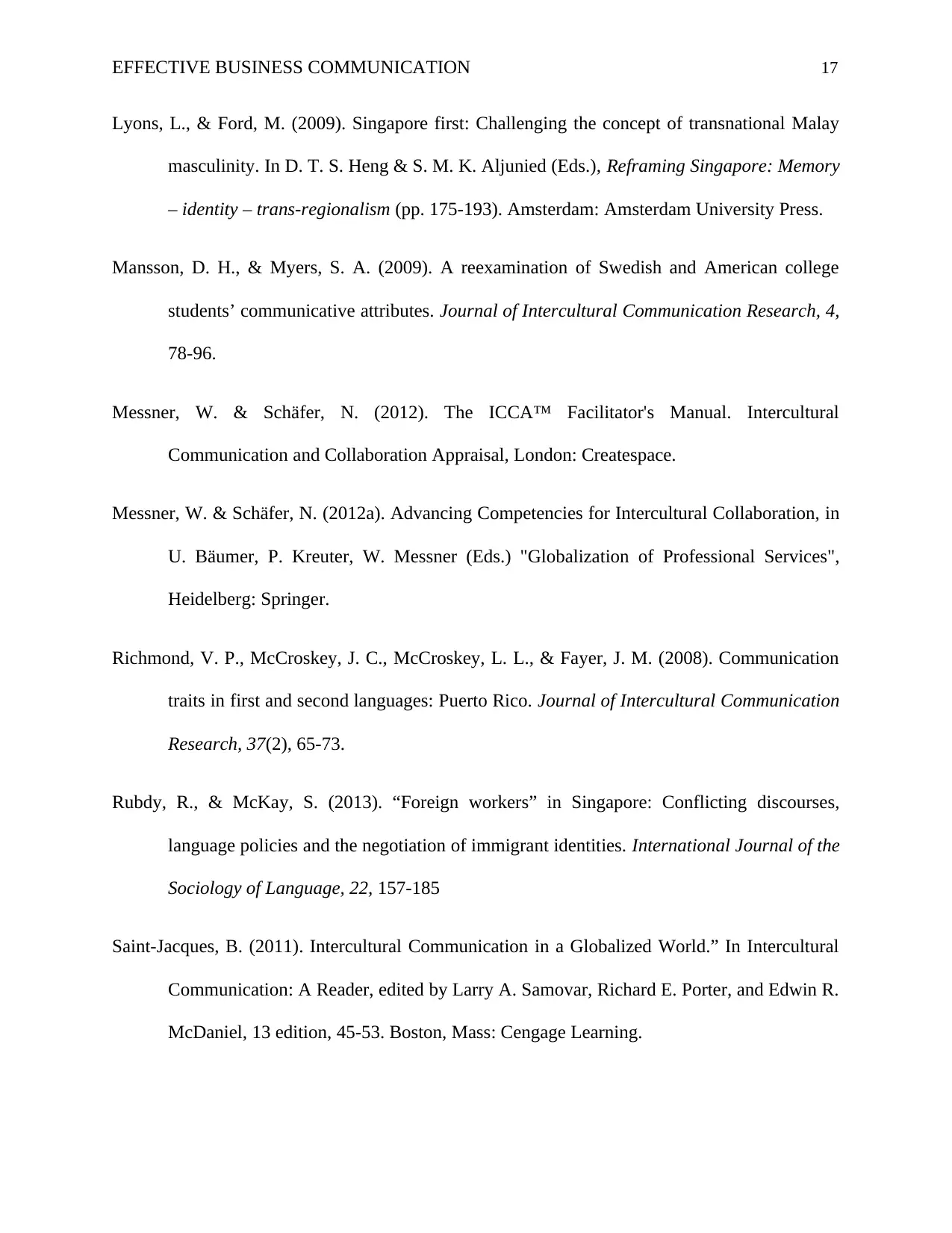
EFFECTIVE BUSINESS COMMUNICATION 17
Lyons, L., & Ford, M. (2009). Singapore first: Challenging the concept of transnational Malay
masculinity. In D. T. S. Heng & S. M. K. Aljunied (Eds.), Reframing Singapore: Memory
– identity – trans-regionalism (pp. 175-193). Amsterdam: Amsterdam University Press.
Mansson, D. H., & Myers, S. A. (2009). A reexamination of Swedish and American college
students’ communicative attributes. Journal of Intercultural Communication Research, 4,
78-96.
Messner, W. & Schäfer, N. (2012). The ICCA™ Facilitator's Manual. Intercultural
Communication and Collaboration Appraisal, London: Createspace.
Messner, W. & Schäfer, N. (2012a). Advancing Competencies for Intercultural Collaboration, in
U. Bäumer, P. Kreuter, W. Messner (Eds.) "Globalization of Professional Services",
Heidelberg: Springer.
Richmond, V. P., McCroskey, J. C., McCroskey, L. L., & Fayer, J. M. (2008). Communication
traits in first and second languages: Puerto Rico. Journal of Intercultural Communication
Research, 37(2), 65-73.
Rubdy, R., & McKay, S. (2013). “Foreign workers” in Singapore: Conflicting discourses,
language policies and the negotiation of immigrant identities. International Journal of the
Sociology of Language, 22, 157-185
Saint-Jacques, B. (2011). Intercultural Communication in a Globalized World.” In Intercultural
Communication: A Reader, edited by Larry A. Samovar, Richard E. Porter, and Edwin R.
McDaniel, 13 edition, 45-53. Boston, Mass: Cengage Learning.
Lyons, L., & Ford, M. (2009). Singapore first: Challenging the concept of transnational Malay
masculinity. In D. T. S. Heng & S. M. K. Aljunied (Eds.), Reframing Singapore: Memory
– identity – trans-regionalism (pp. 175-193). Amsterdam: Amsterdam University Press.
Mansson, D. H., & Myers, S. A. (2009). A reexamination of Swedish and American college
students’ communicative attributes. Journal of Intercultural Communication Research, 4,
78-96.
Messner, W. & Schäfer, N. (2012). The ICCA™ Facilitator's Manual. Intercultural
Communication and Collaboration Appraisal, London: Createspace.
Messner, W. & Schäfer, N. (2012a). Advancing Competencies for Intercultural Collaboration, in
U. Bäumer, P. Kreuter, W. Messner (Eds.) "Globalization of Professional Services",
Heidelberg: Springer.
Richmond, V. P., McCroskey, J. C., McCroskey, L. L., & Fayer, J. M. (2008). Communication
traits in first and second languages: Puerto Rico. Journal of Intercultural Communication
Research, 37(2), 65-73.
Rubdy, R., & McKay, S. (2013). “Foreign workers” in Singapore: Conflicting discourses,
language policies and the negotiation of immigrant identities. International Journal of the
Sociology of Language, 22, 157-185
Saint-Jacques, B. (2011). Intercultural Communication in a Globalized World.” In Intercultural
Communication: A Reader, edited by Larry A. Samovar, Richard E. Porter, and Edwin R.
McDaniel, 13 edition, 45-53. Boston, Mass: Cengage Learning.
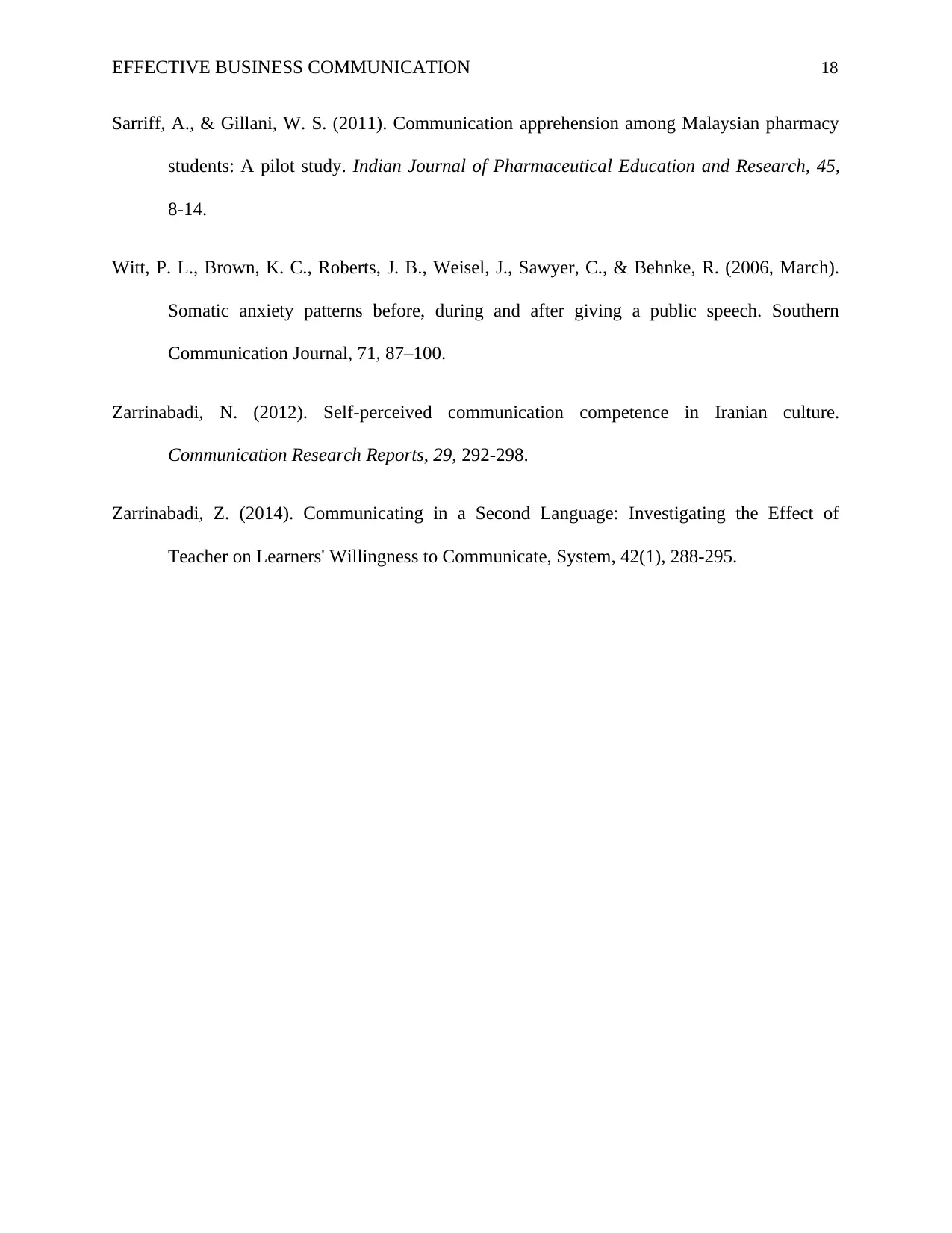
EFFECTIVE BUSINESS COMMUNICATION 18
Sarriff, A., & Gillani, W. S. (2011). Communication apprehension among Malaysian pharmacy
students: A pilot study. Indian Journal of Pharmaceutical Education and Research, 45,
8-14.
Witt, P. L., Brown, K. C., Roberts, J. B., Weisel, J., Sawyer, C., & Behnke, R. (2006, March).
Somatic anxiety patterns before, during and after giving a public speech. Southern
Communication Journal, 71, 87–100.
Zarrinabadi, N. (2012). Self-perceived communication competence in Iranian culture.
Communication Research Reports, 29, 292-298.
Zarrinabadi, Z. (2014). Communicating in a Second Language: Investigating the Effect of
Teacher on Learners' Willingness to Communicate, System, 42(1), 288-295.
Sarriff, A., & Gillani, W. S. (2011). Communication apprehension among Malaysian pharmacy
students: A pilot study. Indian Journal of Pharmaceutical Education and Research, 45,
8-14.
Witt, P. L., Brown, K. C., Roberts, J. B., Weisel, J., Sawyer, C., & Behnke, R. (2006, March).
Somatic anxiety patterns before, during and after giving a public speech. Southern
Communication Journal, 71, 87–100.
Zarrinabadi, N. (2012). Self-perceived communication competence in Iranian culture.
Communication Research Reports, 29, 292-298.
Zarrinabadi, Z. (2014). Communicating in a Second Language: Investigating the Effect of
Teacher on Learners' Willingness to Communicate, System, 42(1), 288-295.
1 out of 18
Your All-in-One AI-Powered Toolkit for Academic Success.
+13062052269
info@desklib.com
Available 24*7 on WhatsApp / Email
![[object Object]](/_next/static/media/star-bottom.7253800d.svg)
Unlock your academic potential
© 2024 | Zucol Services PVT LTD | All rights reserved.


